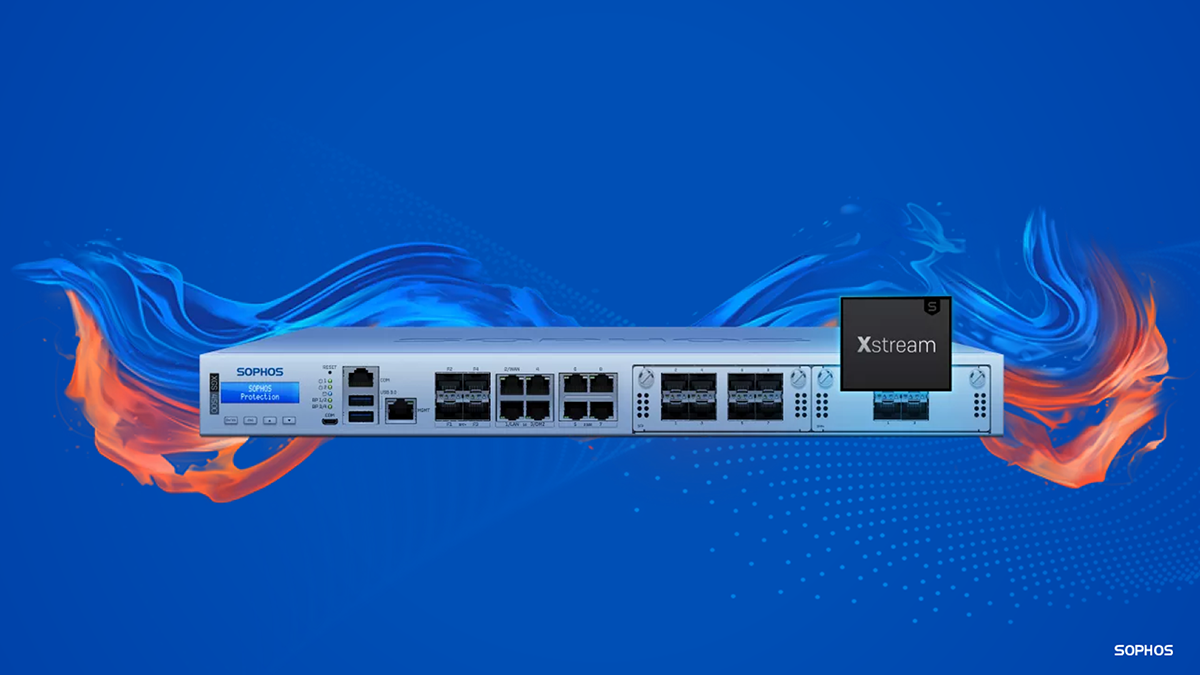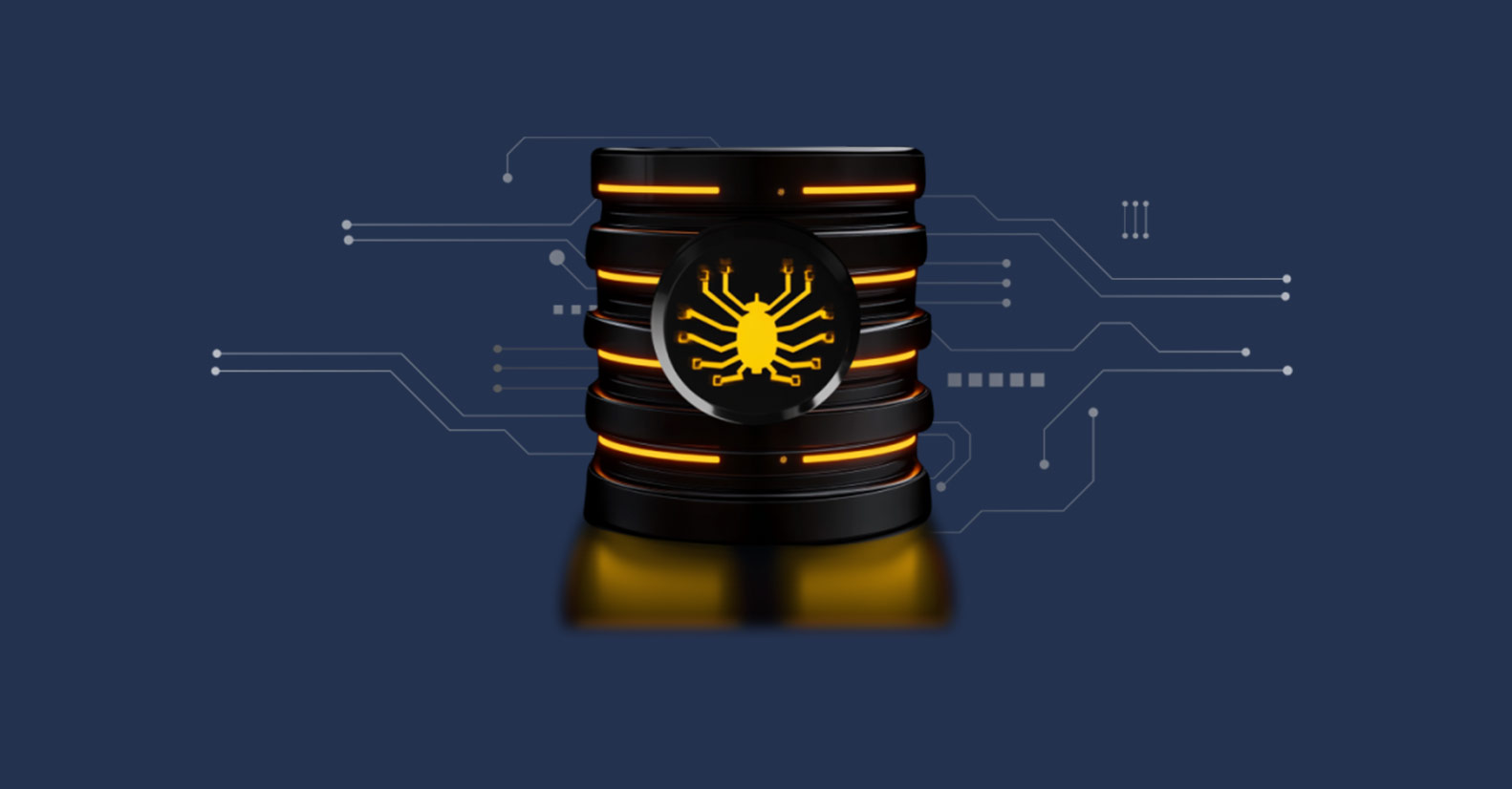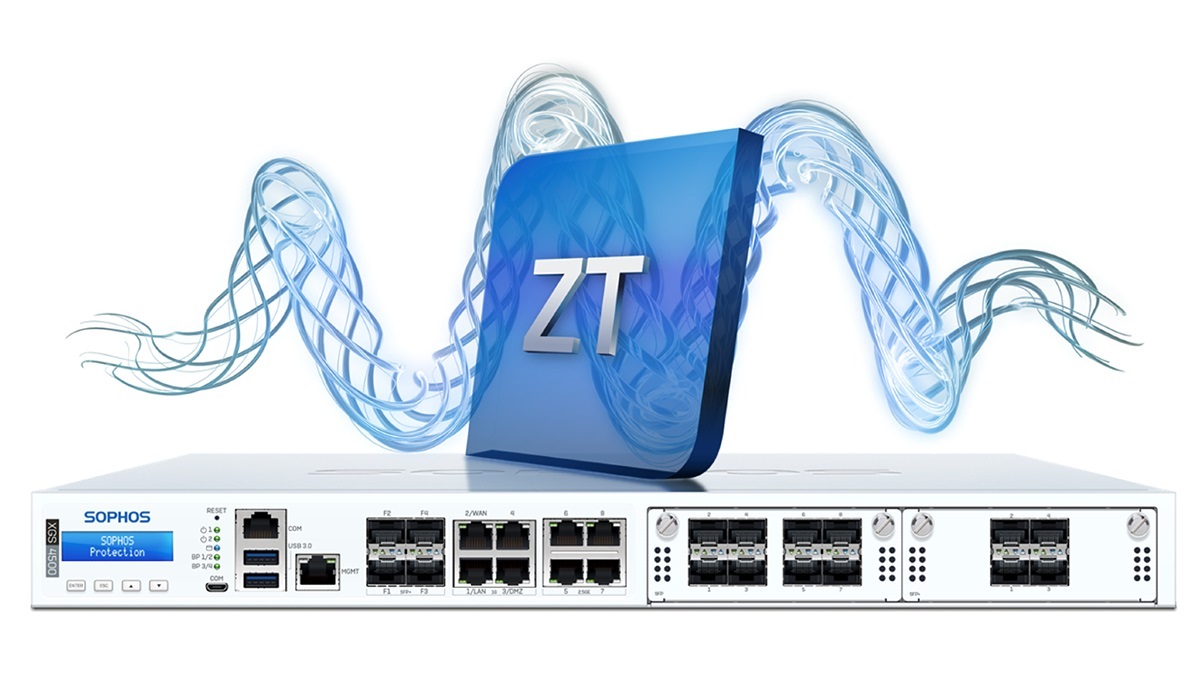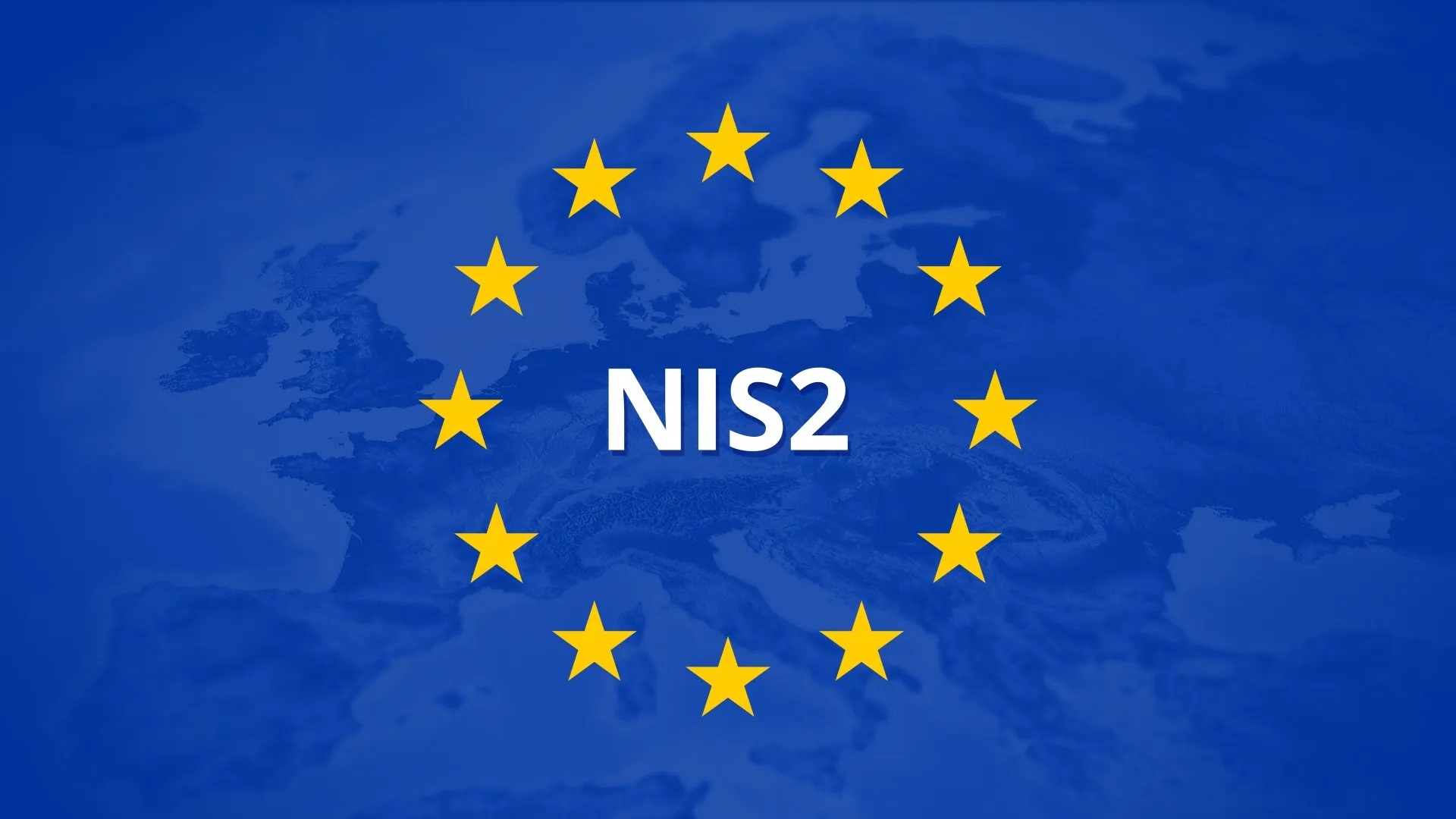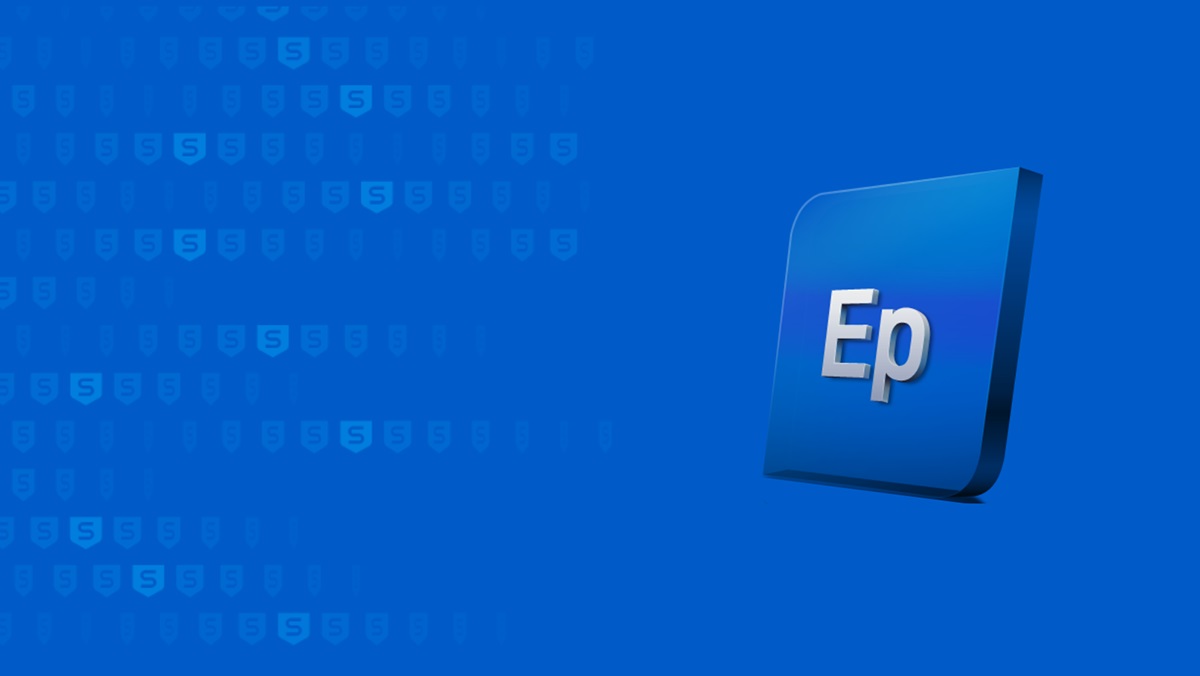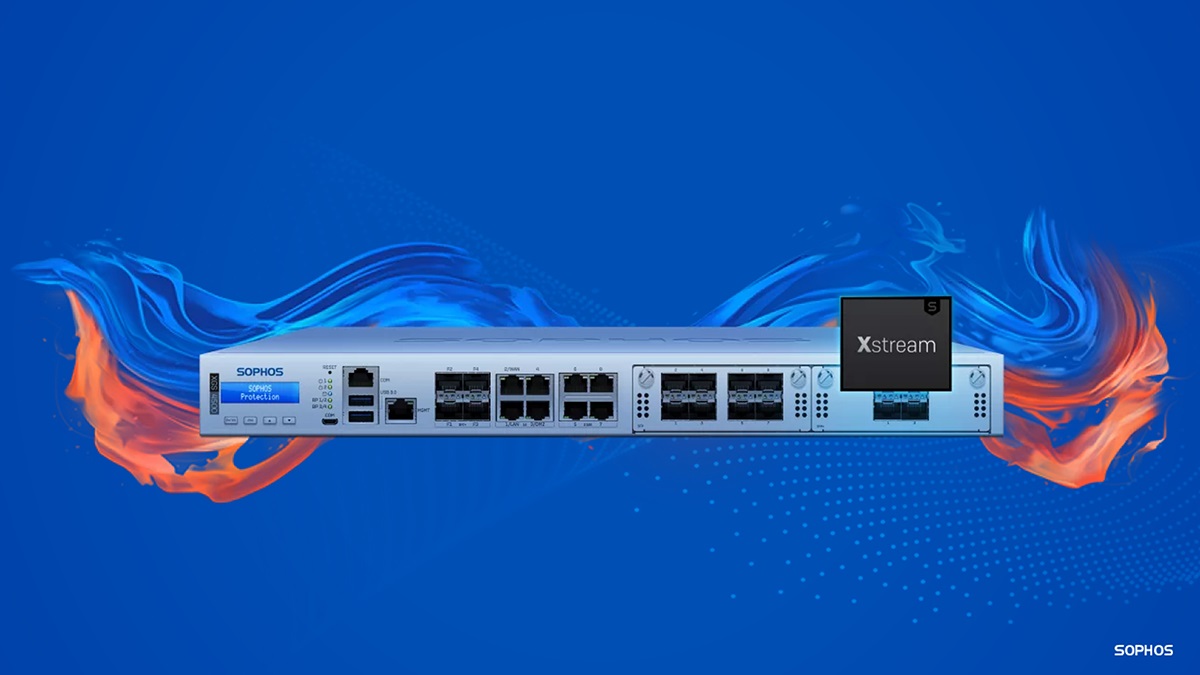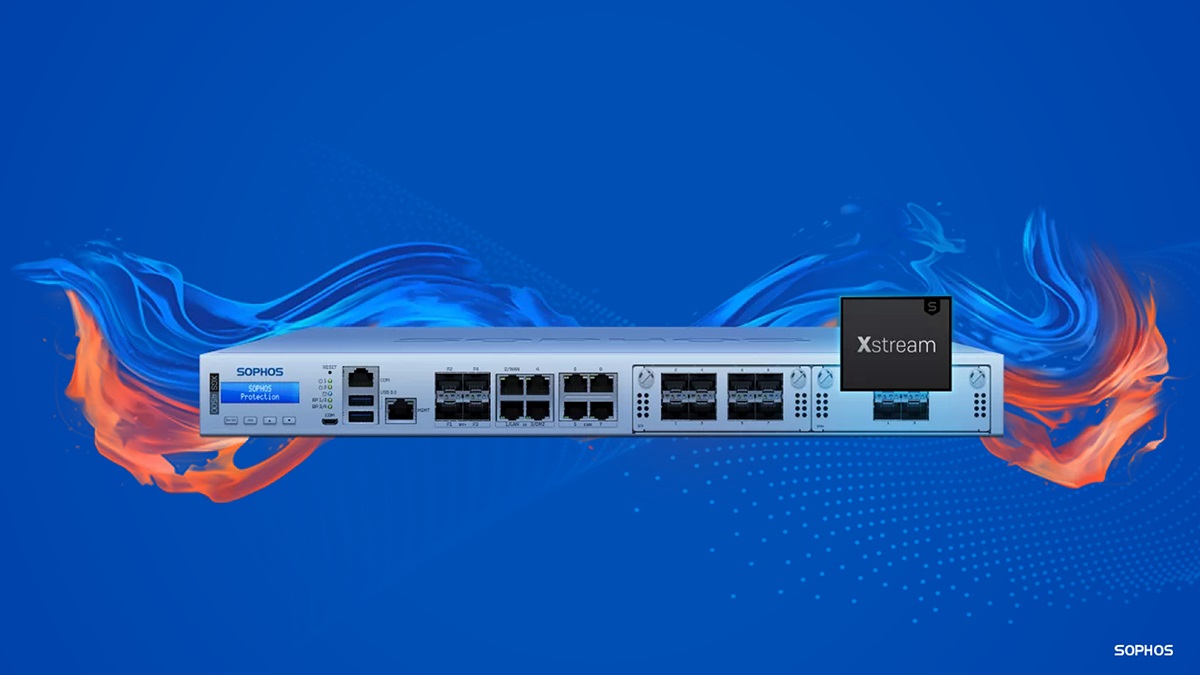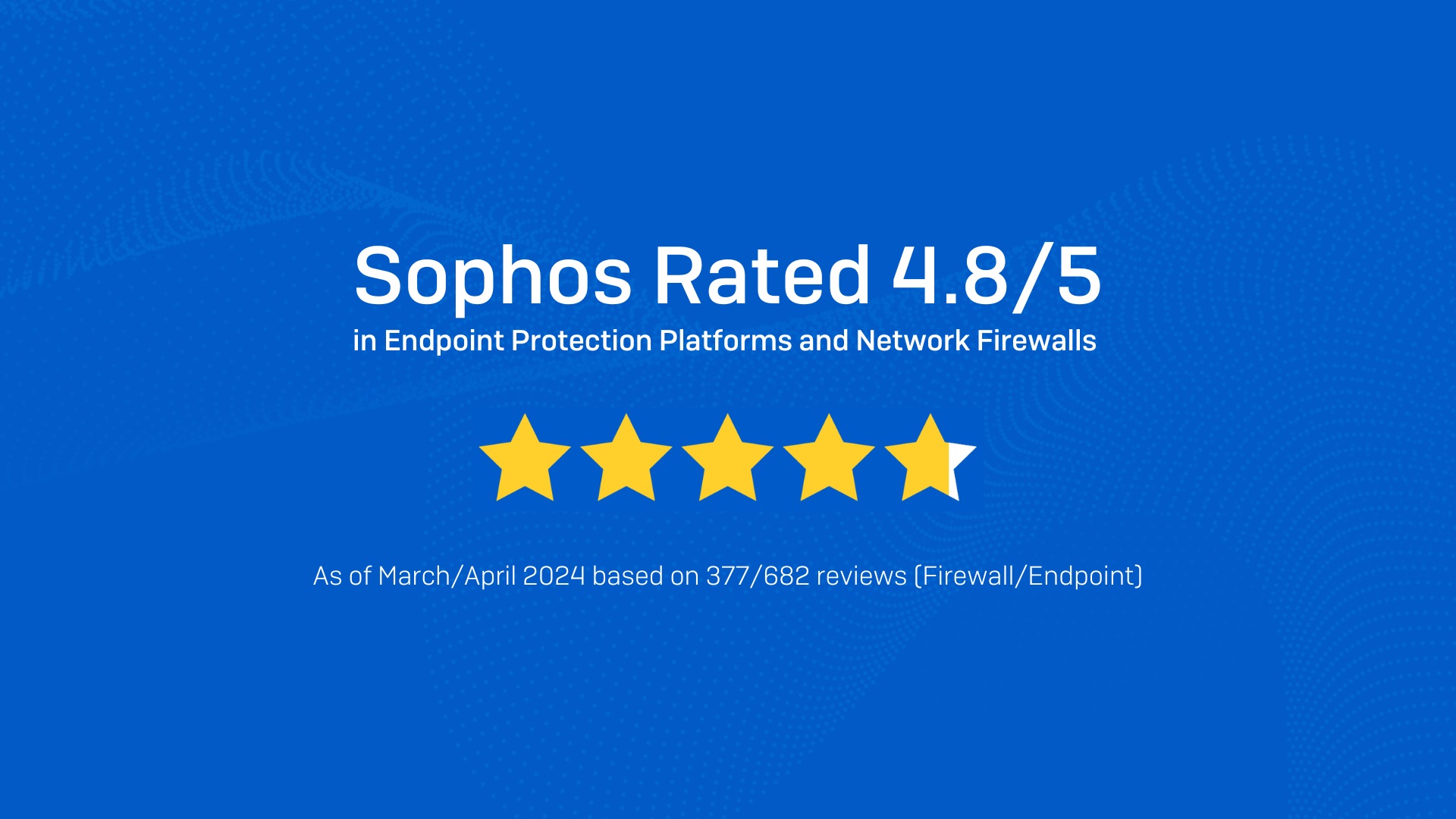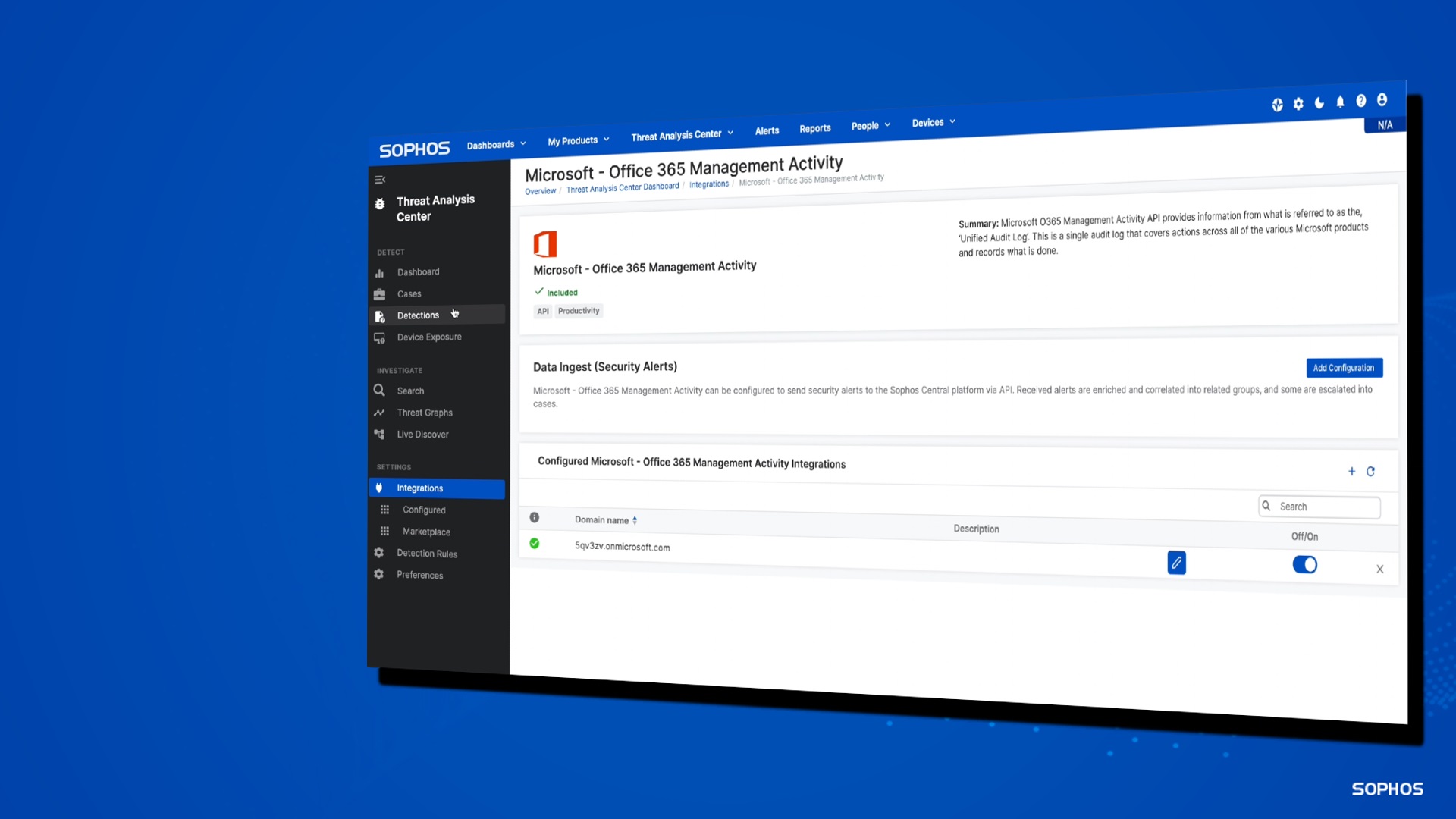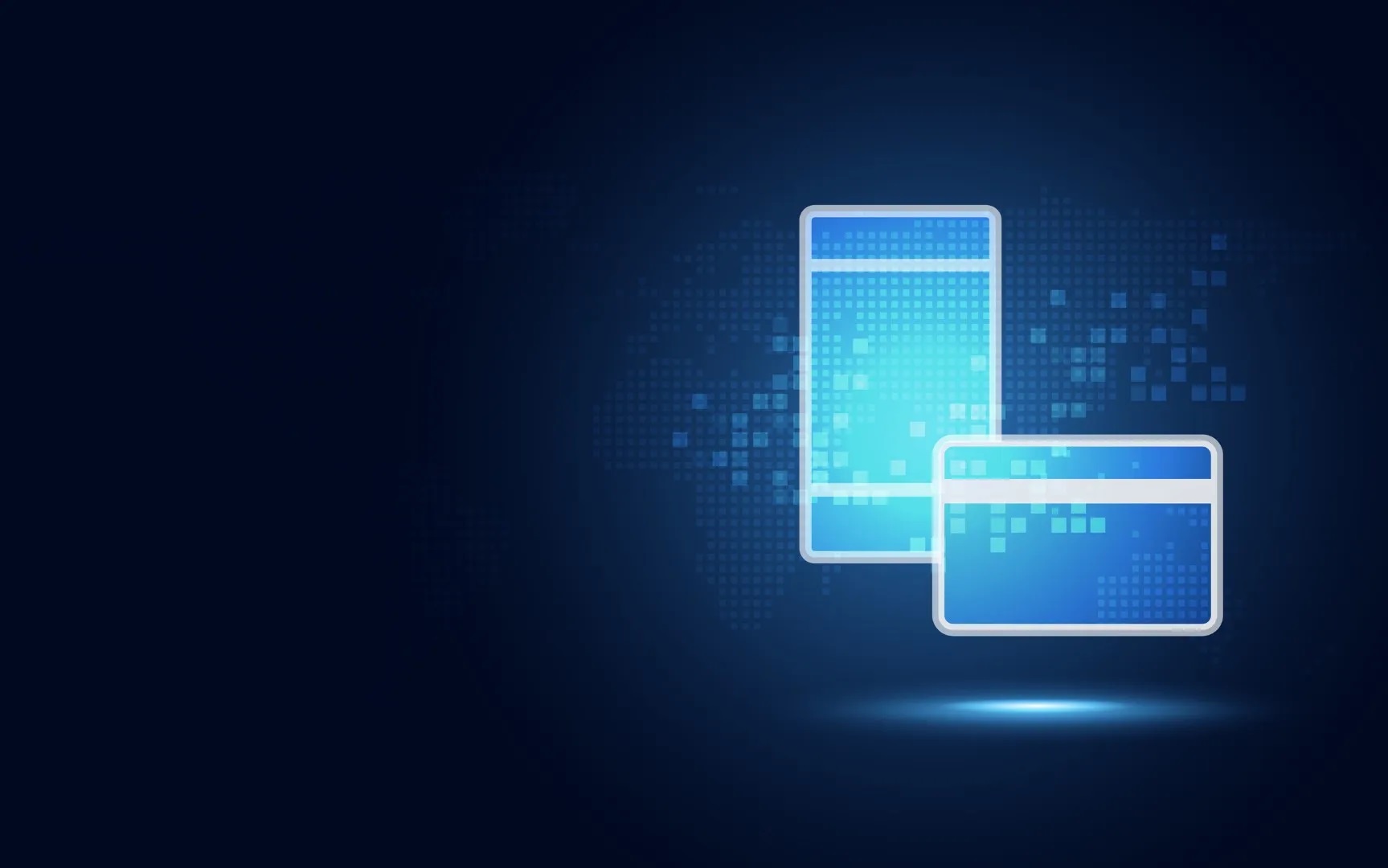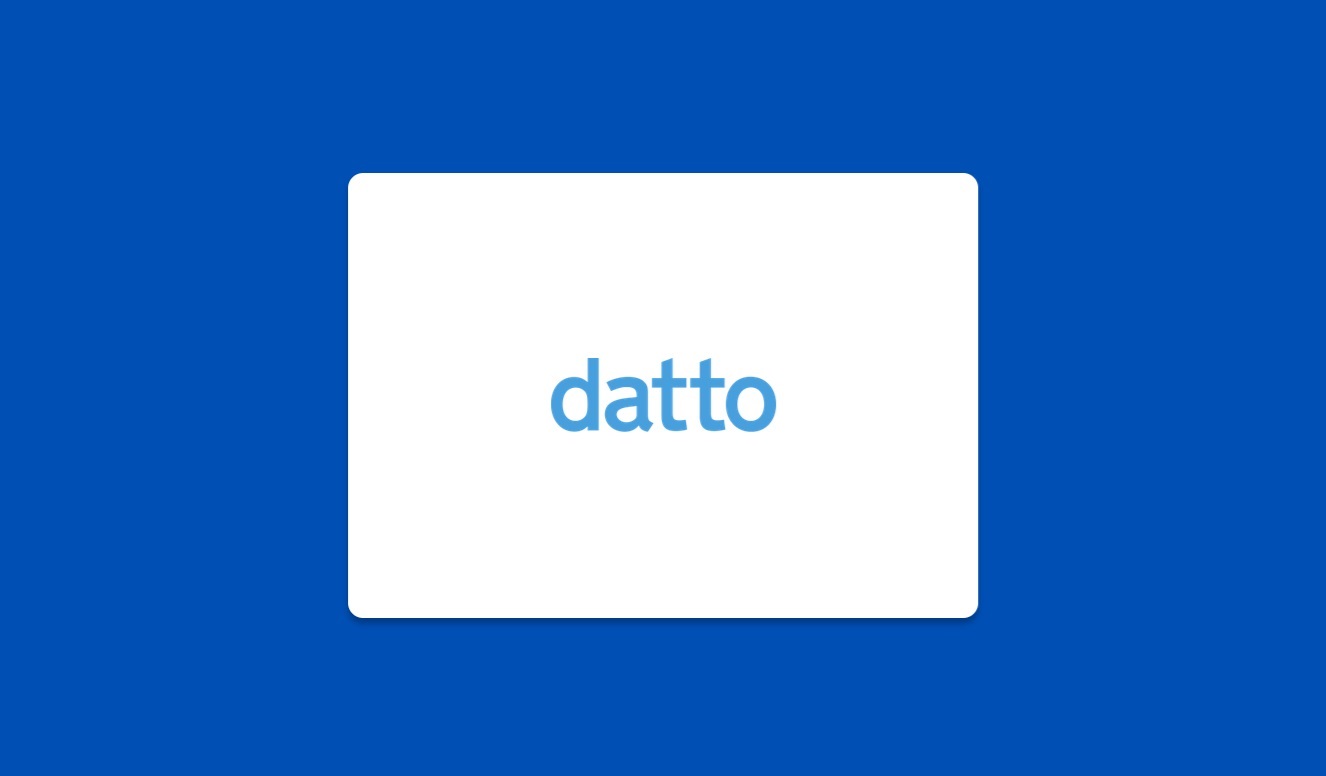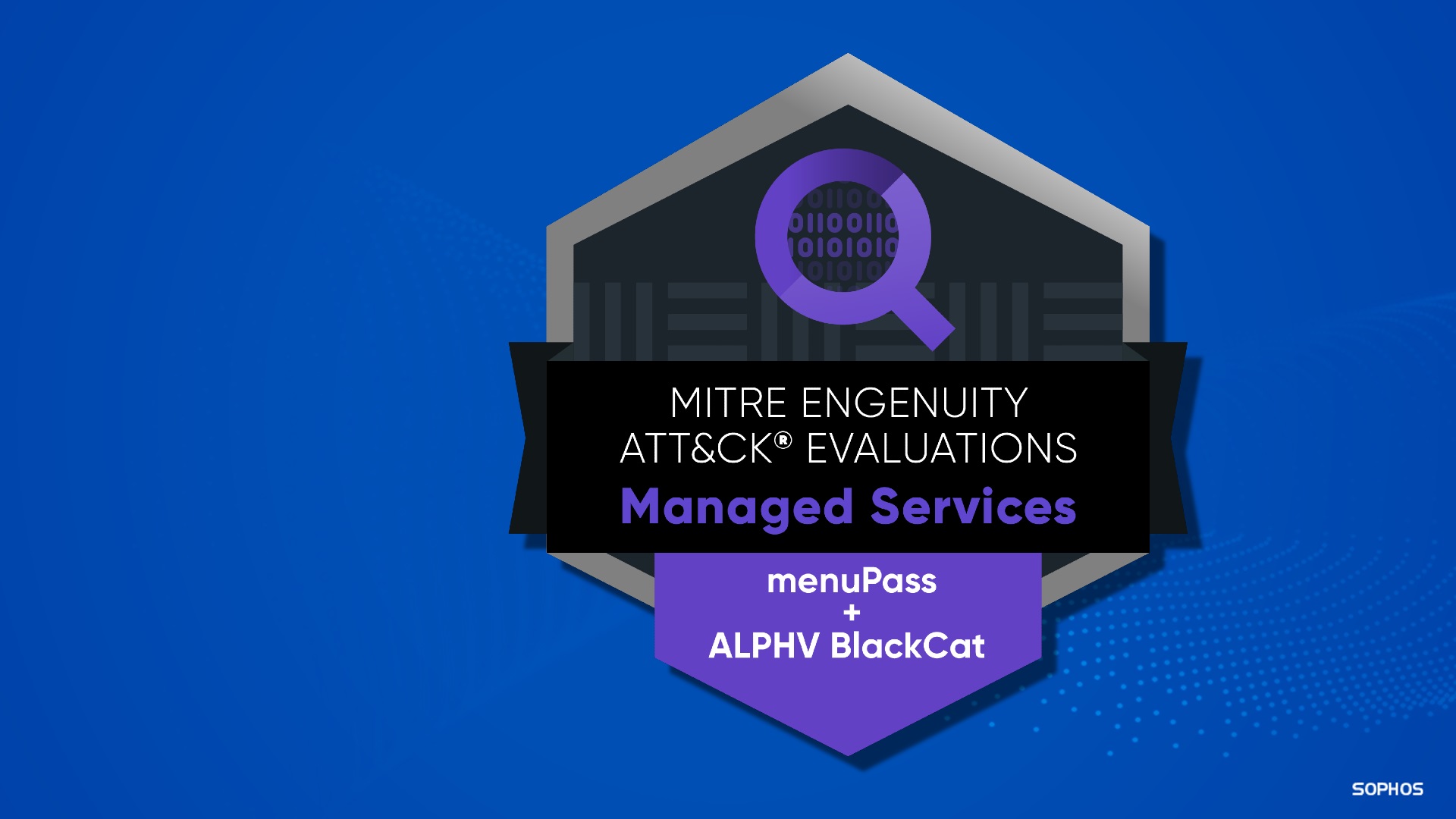News
We’re pleased to announce that the early access program (EAP) is now underway. The latest and greatest Sophos Firewall release brings exciting enhancements and top-requested features, including…
Added protection
- Active Threat Response has been extended with support for third-party threat feeds to enable easier integration with specialized and custom threat intelligence sources
- Synchronized Security’s automated response to active threats is also extended to third-party threat feeds
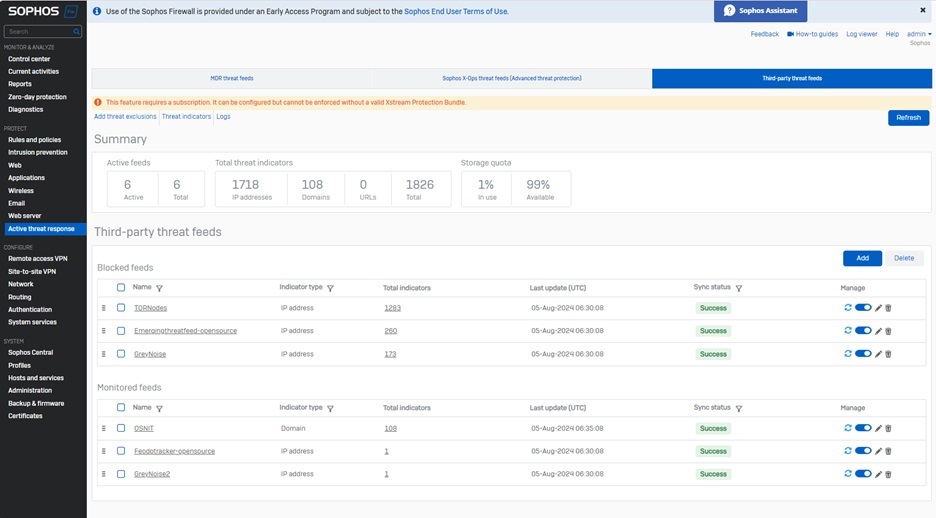
Enhanced scalability
- High-availability (HA) deployments gain added resilience and more seamless transitions for reduced down time
- IPsec VPN gains improved manageability, configuration, and performance
- Authentication and web enhancements
Seamless upgrades
- Any-to-any backup and restore for added flexibility when upgrading
- Port mapping support to make it easy to upgrade to an appliance with a different port configuration
Streamlined management
- Multiple user-experience enhancements, including the overall look and feel, Control Center cards, as well as VPN and static route configuration optimization
- Let’s Encrypt certificate support across many areas of the firewall
- Expanded network object visibility to see where objects are being used

And more!
Download the full What’s New Guide for a complete overview of all the great new features and enhancements in v21.
Getting started today
You can download the upgrade package or installer for v21 from the Sophos Firewall v21 EAP Registration Page. Simply submit your contact info and the download links will be emailed to you straight away.
Sophos Firewall v21 EAP is a fully supported upgrade from all supported versions of v20, v19.5 and v19.0; including the latest v20 MR2.
NOTE: Sophos Firewall v21 does NOT include support for XG and SG Series appliances. XG Series EOL is March 31, 2025.
All support during the EAP will be through our forums on the Sophos Firewall EAP Community.
Please provide feedback using the option at the top of every screen in your Sophos Firewall as shown below or via the Community Forums.

Source: Sophos
Double extortion ransomware is a type of cyber attack in which cybercriminals steal sensitive data and encrypt it. Then, cybercriminals threaten to release the stolen data unless the victim pays a ransom. The additional threat of exfiltration makes this type of cyber attack particularly damaging for organizations, as they face the risk of sensitive data being exposed to the public or sold on the dark web.
Continue reading to learn how double extortion ransomware works and how you can avoid this type of attack.
What is ransomware?
Ransomware is a type of malware – or malicious software – designed to prevent users from accessing their files, data and systems until a ransom is paid. Cybercriminals perform this attack by infecting a user’s device with this specific form of malware that purposefully encrypts the data on their device. In return for the user to gain back access, they demand a ransom.
When a cybercriminal is performing a double extortion ransomware attack, they are not only attempting ransomware but also extorting the data beforehand. They leverage this to increase the ransom payment by threatening to use the stolen data against them.
How double extortion ransomware works
Here is a step-by-step explanation of how a cybercriminal performs a double extortion ransomware attack.
1. Hacker gains access to an organization’s system
Before a cybercriminal can perform a double extortion ransomware attack, they must successfully gain access to an organization’s system. Various methods can be used to gain access to an organization’s systems such as phishing attacks, stealing login credentials, a brute force attack or exploiting a vulnerability in software or a device’s operating system.
2. Hacker moves laterally throughout the network
After a cybercriminal enters into an organization’s system, they move laterally throughout the network to gain increased privileged access to sensitive information and data. While doing so, they’ll also look for ways to prevent themselves from being detected.
3. Hacker steals the organization’s data
Once the cybercriminal gains the privileges needed to steal data, they will remove the data from the device and move it outside the organization’s network.
4. Hacker encrypts data and executes ransomware
The cybercriminal will then hold the data hostage and execute the ransomware attack. The data will become encrypted, making it unreadable and inaccessible to the owner.
5. Victim is notified of the attack
As the ransomware attack occurs, the victim will be notified of the attack on their system through a Distributed Denial-of-Service attack (DDoS) in which the victim’s system becomes disrupted. The user will be given instructions to pay a ransom in exchange for their data back. The data should be returned if the ransom is paid, but sometimes cybercriminals still don’t give the data back. If the ransom isn’t paid at all, the data will either be leaked to the public, deleted or sold.
How to avoid double extortion ransomware attacks
It’s always a security best practice to implement prevention techniques for cyber attacks like ransomware. Here are five ways you can protect your organization from becoming a victim.
Adopt zero-trust security
Zero-trust security is a cybersecurity framework that eliminates implicit trust, requiring all users to be authenticated and authorized before gaining access to network systems. By implementing this strategy in your organization, administrators will have full visibility of who’s connected to the network. More visibility and verification greatly reduce the risk of successful cyber attacks.
Invest in a Privileged Access Management (PAM) solution
Privileged Access Management (PAM) is a cybersecurity solution designed to organize, manage and secure accounts with privileged credentials. Since users with privileged credentials have access to highly sensitive information and data, they become valuable targets to cybercriminals. A PAM solution helps reduce this cyber risk as it allows administrators to securely control access to an organization’s most privileged accounts.
Keep software and Operating Systems (OS) up to date
Updating your device’s software and operating system as soon as an update becomes available ensures that your device will be up to date with the latest security features. If you don’t install a software update, you are more vulnerable to cyber attacks because the security flaws on your device are not patched.
Regularly back up data
By constantly backing up your data, your organization is well protected against human error, hardware failure, data loss, viruses and hackers. For instance, if your organization becomes a victim of double extortion ransomware, having your data backed up can help with recovery and potentially avoid having to pay the ransom.
Train employees on how to spot common cyber threats
Start protecting your organization by educating your employees on common cyber threats targeting your industry. For example, train your employees on how to spot phishing scams by sending them simulated phishing emails throughout their employment.
Stay protected against double extortion ransomware attacks
Falling victim to double extortion ransomware is not only frightening but it could lead to serious consequences for your organization. Fortunately, it’s not impossible for organizations to defend themselves against these ransomware threats.
Start protecting your organization from ransomware by implementing Zero-Trust KeeperPAM® to strengthen the management of your privileged users. To learn more about how Zero-Trust KeeperPAM can protect your organization, request a demo today.
Source: Keeper
Sophos ZTNA provides secure access to networked applications, RDP systems, and web management consoles. It provides a much better alternative to remote access than VPN, offering better security, easier management, and complete transparency for end-users.
To see what ZTNA is all about, we’re offering three free one-year licenses to Sophos Firewall customers, enabling you to start taking advantage of the integrated ZTNA gateway built into every firewall as of v19.5 MR3 and later. Feel free to use them however you like – maybe start with your IT admin staff for remote management and go from there.
The only qualifications for this free offer are that you’re a term Sophos Firewall customer, managing one or more of your firewalls in Sophos Central, and are running v19.5 MR3 or v20 (or later) on your Firewall. This offer will be extended to MSP customers soon.
To take advantage of this offer, simply click the button on the banner in the Firewall Management screen in Sophos Central as outlined below.

If you’re new to Sophos ZTNA, you can learn more about how it can help secure your application access at Sophos.com/ZTNA.
Check out the Deployment Checklist for other considerations when deploying ZTNA.
You can also access the latest online documentation, and the troubleshooting guide has been updated in case you encounter any issues during configuration.
Source: Sophos
Elevate and extend your threat detection and response with deep network insights – available as a self-managed tool with Sophos XDR and with the 24/7 Sophos MDR service.
However skilled an adversary is at covering their tracks, they always need to cross the network. Sophos NDR sits deep within your network, monitoring network traffic using five real-time threat detection engines to identify signs of malicious or suspicious activity.
With Sophos NDR, you can see and stop attackers faster. Leveraging a combination of AI-powered machine learning, advanced analytics, and rule-based matching techniques, it identifies threats that often go undetected until it’s too late, including:
- Threats on unprotected devices like point-of-sale systems, IoT and OT devices, and legacy operating systems
- Rogue assets that adversaries exploit to launch attacks
- Insider threats such as sensitive data uploads to an offsite location
- Zero-day attacks, and more
Plus, when combined with other security telemetry, Sophos NDR enables threat analysts to paint a more complete, accurate picture of the entire attack path and progression, enabling a faster, more comprehensive response.
What’s new in v1.7
We continue to enhance Sophos NDR to further accelerate network threat detection and response. The rich graphical interface and forensic investigation tools in the new Investigation Console enable analysts to dive deeper into your network activity and pinpoint issues sooner. Use cases include:
- Gain comprehensive visibility into all network activity over the past 30 days
- Analyze application activity, flow risks, and communication on non-standard ports
- Monitor network activity over time to identify suspicious patterns and behaviors
- And much more
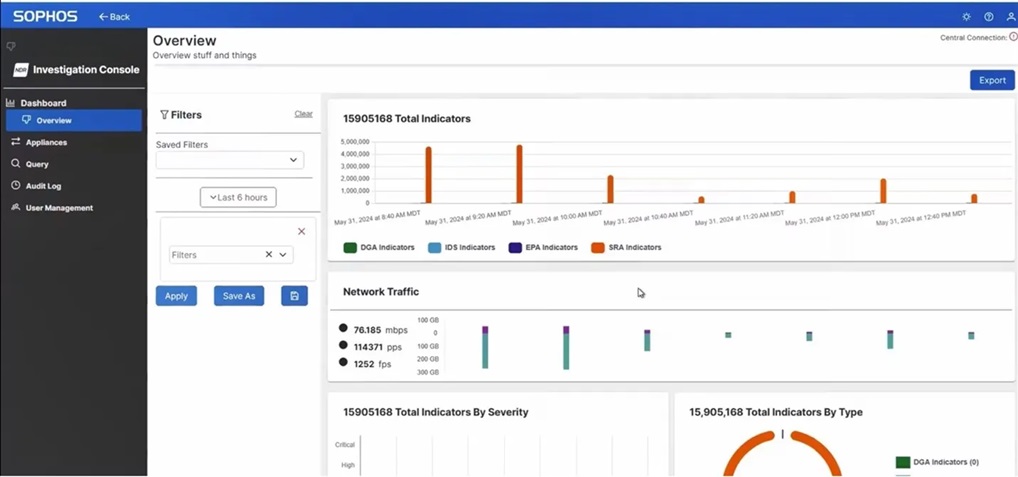
For maximum flexibility, Sophos NDR deploys as a virtual appliance on VMware or Microsoft Hyper-V, in the cloud on AWS, or on a range of certified hardware appliances. The latest version includes a refreshed certified hardware portfolio, including a new entry-level model.
To learn more about the latest enhancements, visit the Sophos NDR community forum
Explore Sophos NDR today
Existing Sophos NDR customers benefit from all the latest enhancements automatically and at no additional charge. To get started, visit the community forum and download the Investigation Console image from Sophos Central.
Sophos NDR is available with the self-managed Sophos XDR tool and our 24/7 fully-managed Sophos MDR service. All Sophos customers can now activate a 30-day free trial directly within their Sophos Central console. To learn more and explore your security operations needs, speak with your Sophos partner or account team.
Source: Sophos
The best ways to keep your sensitive data safe include using strong passwords for each of your online accounts, backing up your data regularly and investing in a password manager. Your data is important and should be protected to reduce the risk of identity theft and other cyber threats.
Continue reading to learn what is considered sensitive data, how to protect your sensitive data and how Keeper® can help.
What is considered sensitive data?
Sensitive data includes different types of Personally Identifiable Information (PII) that can reveal your identity.
Your personal, financial, health and business information is considered sensitive data because it is not available in public records and is kept confidential. However, when your sensitive data is compromised, it can lead to identity theft, unauthorized loans being applied for in your name and major credit card fraud.
6 tips to protect your sensitive data
Luckily, there are several steps you can take to protect your sensitive data and maintain your privacy online.
1. Create strong passwords for all online accounts
The first step to protecting your sensitive data is creating a strong and unique password for each of your accounts. A strong password should contain at least 16 characters and a combination of uppercase and lowercase letters, numbers and symbols. You should also never use personal information in your passwords because a cybercriminal can research this information and use it in their attempts at cracking your passwords. The best passwords are completely random and do not incorporate dictionary words like “password” or “dog” because the more common the words are, the easier your passwords are to guess.
2. Set up Multi-Factor Authentication (MFA)
Multi-Factor Authentication (MFA) is crucial in protecting sensitive data because it prevents unauthorized users from accessing your accounts when enabled. MFA adds an extra layer of security by requiring additional proof of your identity before logging in to your account. Some examples of MFA are a PIN, a code from an authenticator app and a fingerprint scan. One of the benefits of enabling MFA on all your accounts is that even if a cybercriminal gains access to your username and password, they still need the additional factor to log in.
3. Use a VPN on public WiFi
Something as simple as connecting to public WiFi can put your sensitive data at risk of being compromised, which is why you should use a Virtual Private Network (VPN). When you use public WiFi, you never know if a cybercriminal has manipulated the network to collect data from anyone who connects to it in what is called a Man-in-the-Middle (MITM) attack. To combat cyber threats like MITM attacks, using a VPN protects your online privacy by creating a private network to encrypt your data, even when you are connected to a public network. For example, if you connect to airport WiFi while traveling, you should use a VPN to ensure that no one in the airport can steal your private information.
4. Enable data encryption
Data encryption is the process that converts your sensitive data from plain text, which anyone can read, into ciphertext, which has random characters that neither people nor machines can read until it’s been decrypted with an encryption key. This process may sound confusing, but encrypting your data ensures that it isn’t read by another user.
You can enable data encryption on your smartphones, computers and online accounts by visiting your device’s settings. For Windows users, within your Settings, visit Privacy & security, then click on Device encryption. If this setting does not appear for you, use BitLocker encryption, which is a Windows security feature that encrypts an entire drive to protect data. Search for BitLocker in your Windows search box, then select BitLocker Drive Encryption and click Turn on BitLocker. For Apple users, your sensitive data is automatically encrypted when you set up a passcode and Touch/Face ID on your device. In the Face ID & Passcode section within your settings, you should see Data protection is enabled at the very bottom of your screen to indicate this.
5. Back up your data regularly
Not only is it important to back up your data regularly in case your device is ever lost or stolen, but you should also continuously back up your data in case your device suffers a malware attack. Imagine you never backed up your phone when, all of a sudden, it was infected with a virus. If you had backed up your data before the virus infected your phone, you could erase all the data on your phone and restore it using the backup made before the infection.
6. Invest in a password manager
Protecting your sensitive data is convenient and secure when you use a password manager like Keeper. Password managers can create strong and unique passwords, safely store your login credentials in an encrypted vault and make it easy to log in to accounts automatically. There are many benefits to using a password manager, such as its ability to generate random passwords, secure password-sharing features and storage of additional information beyond passwords (documents, PDFs, pictures, medical information, etc.). All you need to remember is your master password, which is the password you use to log in to your secure digital vault.
Trust Keeper to protect your sensitive information
The password manager you can trust to protect your sensitive data is Keeper. Keeper uses end-to-end AES-256 encryption to ensure that your sensitive data cannot be accessed by anyone except you. With our zero-knowledge security, Keeper cannot even see your encrypted data. Using Keeper Password Manager allows you to generate and store MFA codes, and it can even autofill these codes on their associated websites for an easier login process.
Start your free 30-day trial of Keeper Password Manager today to discover all that Keeper can do to protect your sensitive data.
Πηγή: Keeper Security
As we approach the October 2024 deadline for EU Member States to enact the NIS 2 Directive, organizations that do business in Europe must prepare for the significant changes it brings to cybersecurity compliance.
This article aims to shed light on the NIS 2 Directive, its necessity, key updates from the original NIS Directive, and how businesses can prepare for compliance. For an even deeper dive on the directive, download the Sophos NIS 2 Directive whitepaper.
What is the NIS 2 Directive?
The NIS 2 Directive is an evolution of the original Network and Information Systems (NIS) Directive, implemented to bolster the cybersecurity posture of EU member states. The initial NIS Directive, enacted in 2016, established guidelines for improving cybersecurity resilience across the EU. However, with the increasing sophistication and frequency of cyber-attacks, especially during and after the Covid-19 pandemic, there was a clear need for more stringent and comprehensive regulations.
Cyber threats have escalated to an industrial scale, with ransomware attacks becoming particularly prevalent. In June 2024, a hacking group known as Qilin, with ties to the Kremlin, carried out an attack on Synnovis, which is a pathology lab used by the UK’s National Health Service (NHS). The hackers demanded a £40 million ransom, and when the NHS refused to pay, hackers released the stolen data on the dark web.
Additionally, geopolitical tensions, such as the Russian invasion of Ukraine, have underscored the necessity for robust cybersecurity measures. The NIS 2 Directive aims to address these challenges by enhancing the security and resilience of essential and important entities across the EU.
Implications for non-EU Companies
While primarily aimed at EU Member States, non-EU companies operating within the EU or providing services to EU entities will also be impacted. Many national regulations are currently not as wide-ranging as the NIS 2 Directive; however, it would be prudent to expect further changes to local law as the plans for the EU legislation are developed further.
By proactively addressing the challenges outlined below, non-EU companies can better protect themselves and their customers from evolving cyber threats while avoiding severe penalties for non-compliance.
Key updates from NIS to NIS 2
The NIS 2 Directive introduces several critical updates and expansions from the original NIS Directive:
- Broader Scope of Covered Entities:
- Essential and Important Entities: NIS 2 categorizes entities into “essential” and “important” based on their sector and criticality. This expansion includes more sectors, such as wastewater, healthcare supply chains, postal and courier services, aerospace, public administration, and digital infrastructure.
- Supply Chain and Service Providers: Organizations involved in the supply chain and those providing critical support services are now explicitly covered, emphasizing the importance of securing interconnected networks.
- Enhanced Cybersecurity Standards:
- Mandatory Measures: Article 21 of the directive outlines mandatory cybersecurity measures, including basic cyber hygiene, vulnerability management, supply chain security, encryption, asset management, access control, and zero trust security.
- Incident Handling and Reporting: The directive mandates more rigorous incident reporting requirements, ensuring timely and consistent responses to cyber threats across the EU.
- Increased Accountability and Penalties:
- Senior Management Liability: Senior management can be held personally liable for non-compliance, underscoring the importance of executive involvement in cybersecurity governance.
- Fines and Sanctions: Organizations can face significant fines, up to €10 million or 2% of global turnover, for failing to comply with the directive.
The following 18 sectors are covered by the NIS 2 Directive:

The following table illustrates the increase in sectors covered by the NIS 2 Directive as compared to the first NIS directive:
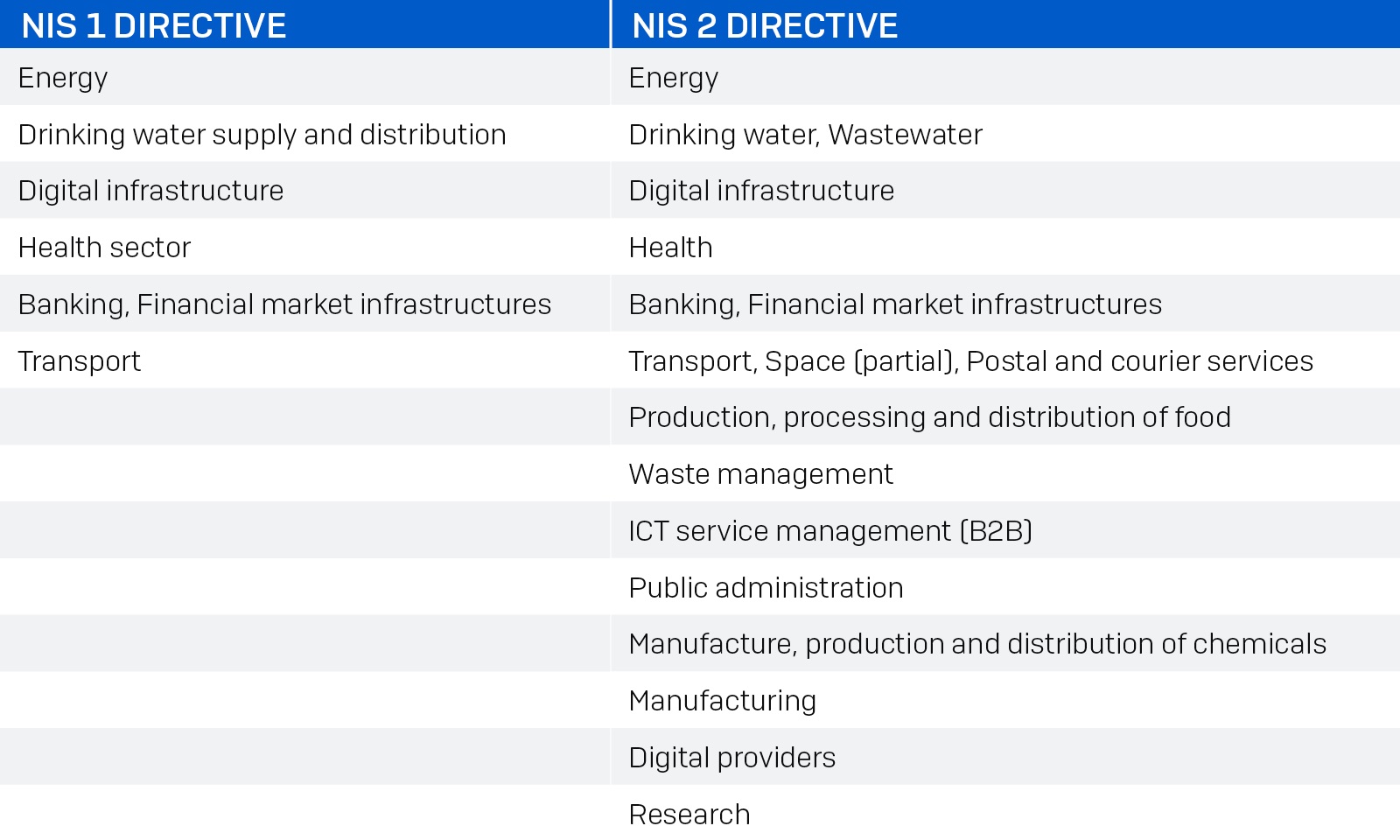
Impact on cybersecurity compliance
The NIS 2 Directive significantly impacts how organizations approach cybersecurity compliance. Businesses must adopt a proactive stance, integrating comprehensive risk management processes and ensuring adherence to the stringent standards set forth in the directive. The emphasis on mandatory measures and the potential for severe penalties necessitate a thorough review and enhancement of existing cybersecurity practices.
Organizations will need to allocate sufficient resources to meet these requirements. Estimates suggest that businesses already covered by the original NIS Directive may need to increase their cybersecurity budgets by up to 12%, while those newly covered could see budget increases of up to 22%, according to John Noble, former Director of the National Cyber Security Centre speaking on Sophos Spotlight: NIS2 Directive and Understanding Cybersecurity Compliance.
Preparing for NIS 2 compliance
To ensure compliance with the NIS 2 Directive, organizations should take the following steps:
- Assess Applicability:
- Determine whether your organization falls under the categories of essential or important entities. This involves evaluating your sector, the criticality of your services, and your operational footprint within the EU.
- Understand Jurisdiction:
- Identify which EU member states have jurisdiction over your operations for NIS 2 purposes. This is crucial for understanding specific national requirements and reporting obligations.
- Implement Cybersecurity Risk Management:
- Conduct a comprehensive risk analysis to identify potential cybersecurity threats and vulnerabilities.
- Implement the mandatory measures outlined in Article 21, mapping them against an appropriate security framework such as ISO 27001 or the NIST Cybersecurity Framework.
- Strengthen Supply Chain Security:
- Focus on mitigating risks within your supply chain, particularly concerning software and service providers. This includes ensuring that third-party vendors comply with NIS 2 standards.
- Develop an Incident Response Plan:
- Formalize an incident response plan that includes clear protocols for reporting cyber incidents to relevant national authorities. Ensure that significant incidents are reported within the 24-hour timeframe specified by the directive.
- Engage Senior Management:
- Secure formal high-level management sign-off on your compliance strategy. Senior management involvement is critical for demonstrating a commitment to cybersecurity and ensuring that necessary resources are allocated.
The NIS2 Directive represents a significant step forward in enhancing the cybersecurity resilience of organizations across Europe. By understanding the key updates and taking proactive measures to ensure compliance, businesses can better protect themselves against the growing threat of cyber-attacks.
As the October deadline approaches, it is imperative for senior management and IT security professionals to prioritize NIS 2 compliance, leveraging resources such as the Sophos whitepaper to guide their efforts.
Source: Sophos
The U.S. government recently announced that it is banning the sale of Kaspersky antivirus products due to national security concerns. If you’re in the U.S. and currently use Kaspersky products today, you have a tight deadline to switch to an alternative provider. After September 29, 2024, U.S. organizations will no longer receive updates or support from Kaspersky. Outside the U.S., many Kaspersky users are also re-evaluating their endpoint security provision.
Thankfully, wherever you are based, you can migrate to Sophos Endpoint in minutes.
Stronger endpoint security for small and midsize businesses
Sophos Endpoint is trusted by over 300,000 organizations worldwide, including thousands of small and midsize businesses. With Sophos Endpoint, you benefit from:
- Affordable threat protection | Enterprise-grade cybersecurity that’s cost-effective for businesses of any size.
- Quick and easy setup | Install and go with simple, one-time installation – including automatic removal of Kaspersky antivirus when you run the Sophos Endpoint installer.
- Simple management and reporting | A single cloud-based dashboard for security alerts, reporting, and management. Recommended security settings are enabled automatically when you install Sophos Endpoint; no complex configuration is required.
The ban on Kaspersky products in the U.S. provides an opportunity to uplevel your defenses. IT security teams around the globe are seeking replacement solutions that provide the best protection and usability, and less management burden. Moving to Sophos Endpoint enables you to leverage superior protection with additional capabilities and benefits that other solutions lack, including:
- Adaptive defenses | Industry-first dynamic defenses that automatically adapt in response to hands-on-keyboard attacks, reducing the attack surface and stopping sophisticated adversaries in their tracks. Watch this quick demo.
- Remote ransomware protection | Sophos provides the most robust zero-touch endpoint defense against remote ransomware. Alternative endpoint security solutions, including Microsoft, CrowdStrike, and SentinelOne, cannot protect against this increasingly pervasive threat.
- Automated account health check | Misconfigured policy settings can compromise your security posture. The Account Health Check identifies security posture drift and risky configurations, enabling administrators to remediate issues with one click.
Learn more about the advantages of Sophos compared to other cybersecurity solutions and watch the overview video to learn more.
Top-rated by customers, industry analysts, and independent testers
Don’t take our word for it! Customers have named Sophos a 2024 Gartner® Peer Insights™ Customers’ Choice for Endpoint Protection Platforms for the third consecutive year. Sophos stands tall with an impressive customer rating of 4.8/5 (as of April 30, 2024) and the highest number of independent Gartner-verified reviews of any vendor.
Analyst firm IDC evaluates how endpoint security solutions meet customers’ needs and named Sophos a Leader in the 2024 IDC MarketScape for Modern Endpoint Security for Small and Midsized Businesses. According to the IDC MarketScape evaluation, “Sophos is a strong consideration for small businesses, particularly those with large business security requirements that have little to no in-house security expertise.”

See our wide range of third-party endorsements and evaluations.
Time to upgrade to a fully managed security service?
Cybersecurity is becoming so complex that many small and midsize businesses can’t keep up. Replacing Kaspersky antivirus products could be the ideal opportunity to consider taking advantage of a 24/7 managed security service.
Trusted by over 23,000 organizations worldwide, Sophos Managed Detection and Response (MDR) enables you to reduce the risks and costs associated with potentially catastrophic security incidents. Moreover, all Sophos MDR subscriptions include the Sophos Endpoint product within the standard price.
Learn more about Sophos Endpoint on the Sophos website.
Source: Sophos
Sophos Firewall v20 MR2 includes important enhancements such as an exciting new backup and restore assistant, Active Directory SSO improvements, and web protection optimizations.
Backup and restore assistant
The new Sophos Firewall backup and restore assistant enables firewall configuration backups to be easily restored on a different firewall appliance with flexible interface mapping options.
This makes it easy to upgrade Sophos Firewall XG Series to XGS Series, upgrade any XGS Series model to any other XGS Series model, or even migrate to or from software or virtual appliances.
This also means you can easily migrate interfaces to higher-speed ports on your new or upgraded firewall.
You can also get creative and export a configuration template from a virtual appliance and then restore it on multiple hardware or virtual deployments to simplify repetitive configurations.

There are a few key dependencies or pre-requisites to take full advantage of this new assistant:
- Backups of XG Series appliances should be made using v19.5 MR4, v20, or later.
- Backups of XGS Series appliances need to be made using this release: v20 MR2 (or later)
This video covers the prerequisites and how to use this new assistant in more detail:
You can also check the compatibility of the appliances you plan to back up/restore and see the exact port configuration (including available Flexi Port modules) using a new tool that is available at https://docs.sophos.com/nsg/sophos-firewall/reference/backup_restore/port_mapping/en-us/
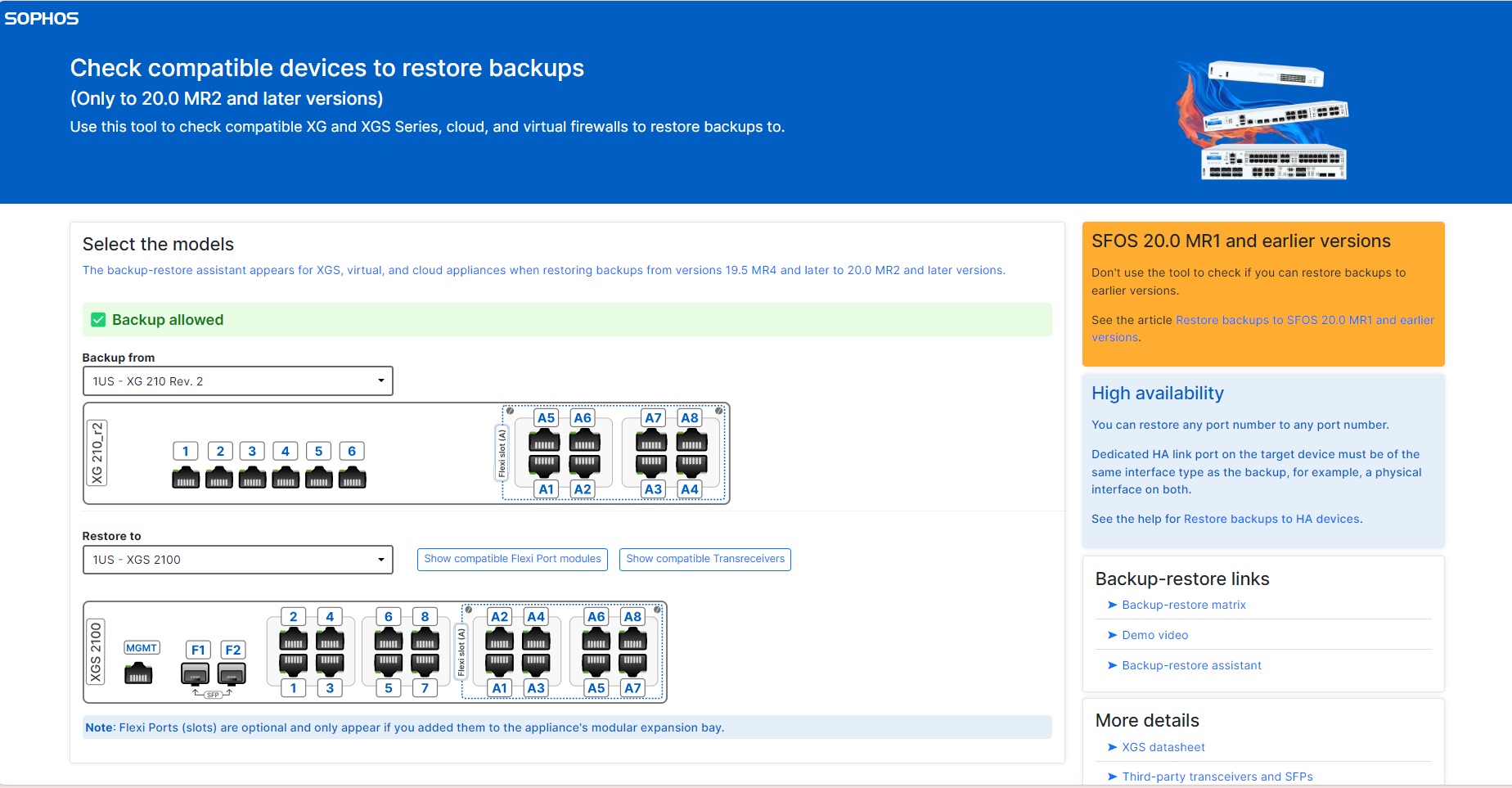
Additional enhancements in Sophos Firewall v20 MR2
- Active Directory Single Sign-on now provides improved support for high-availability failover situations
- Active Directory Single Sign-on adds support for performing the Kerberos/NTLM handshake over HTTP or HTTPS for a more transparent SSO experience when HSTS is enforced
- Web Protection performance is enhanced by reducing the system load when enforcing SafeSearch, YouTube restrictions, Google App login domain, or Azure AD tenant restrictions
- Web Protection cipher customization now enables you to strike the best balance for your network between cipher compatibility, security, and audit compliance
How to get the firmware and documentation
Sophos Firewall OS v20 MR2 is a free upgrade for all licensed Sophos Firewall customers and should be applied to all supported firewall devices as soon as possible to ensure that you have all the latest security, reliability, and performance fixes.
This firmware release will follow our standard update process. You can manually download SFOS v20 MR2 from Sophos Central and update anytime. Otherwise, it will be rolled out to all connected devices over the coming weeks. A notification will appear on your local device or Sophos Central management console when the update is available, allowing you to schedule the update at your convenience.
Sophos Firewall OS v20 MR2 is a fully supported upgrade from all previous versions of v20, v19.5 and v19.0. Please refer to the Upgrade Information tab in the release notes for more details.
Full product documentation is available online and within the product.
Source: Sophos
The latest annual Sophos study of the real-world ransomware experiences of energy, oil/gas and utilities sector – a core element of the critical infrastructure supporting businesses – explores the full victim journey, from attack rate and root cause to operational impact and business outcomes.
This year’s report sheds light on new areas of study for the sector, including an exploration of ransom demands vs. ransom payments and how often energy, oil/gas and utilities organizations receive support from law enforcement bodies to remediate the attack.
Download the report to get the full findings.
Attack rates and recovery rates have remained steady
67% of energy, oil/gas and utilities organizations were hit by ransomware in 2024, identical to the attack rate reported in 2023.

98% of energy, oil/gas and utilities organizations hit by ransomware in the past year said that the cybercriminals attempted to compromise their backups during the attack. Four in five (79%) of these backup compromise attempts were successful, the highest rate of successful backup compromise across all sectors.
80% of ransomware attacks on energy, oil/gas and utilities organizations resulted in data encryption in 2024, in line with the encryption rate reported by this sector in 2023 (79%) but higher than the 2024 cross-sector average of 70%.
The mean cost in energy, oil/gas and utilities organizations to recover from a ransomware attack was $3.12M in 2024, similar to the $3.17M reported in 2023.
Devices impacted in a ransomware attack
On average, 62% of computers in energy, oil/gas and utilities are impacted by a ransomware attack, considerably above the cross-sector average of 49%. Unlike other sectors where only a small percentage of organizations have their full environments encrypted, approximately one in five energy, oil/gas and utilities organizations (17%) reported that 91% or more of their devices were impacted.
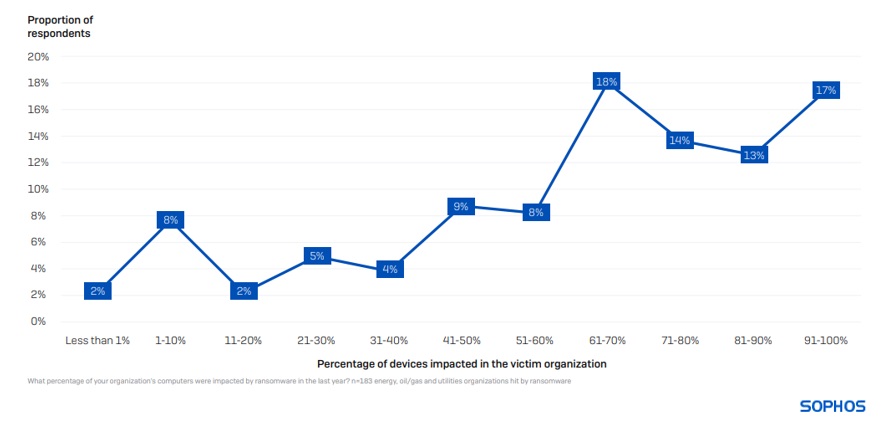
The propensity to use backups for data recovery has decreased
61% of energy, oil/gas and utilities organizations paid the ransom to get encrypted data back, whereas only 51% restored encrypted data using backups – the lowest rate of backup use reported across all sectors. This is the first time that energy, oil/gas and utilities organizations have reported a higher propensity to pay the ransom than use backups. In comparison, globally, 56% paid the ransom, and 68% used backups.
This year’s findings represent a marked change from the previous two years when the sector enjoyed impressive rates of backup use (70% in 2023 and 77% in 2022).

A notable change over the last year is the increase in the propensity for victims to use multiple approaches to recover encrypted data (e.g., paying the ransom and using backups). This time, 35% of energy, oil/gas and utilities organizations that had data encrypted reported using more than one method, higher than the 26% reported in 2023.
Critical Infrastructure victims don’t often pay the initial ransom sum demanded
86 energy, oil/gas and utilities respondents whose organizations paid the ransom shared the actual sum paid, revealing that the average (median) payment was $2.5M in 2024.
A little less than half (48%) of respondents said their payment matched the original request. 26% paid less than the original demand, and 27% paid more.
Looking at the data by industry, energy, oil/gas and utilities has the highest propensity to pay the original ransom amount demanded by attackers. It is also the sector with the second lowest propensity to pay less than the original demand.
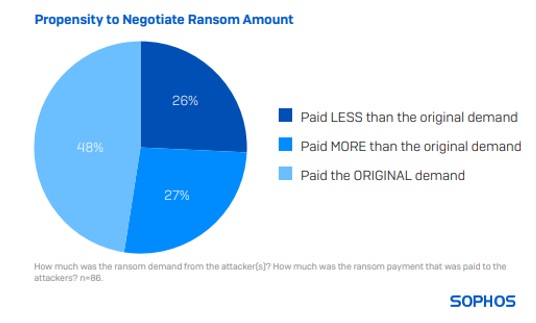
Download the full report for more insights into ransom payments and many other areas.
Source: Sophos
As a Sophos Firewall customer, your security is our top priority. We’ve not only invested heavily in ensuring Sophos Firewall is the most secure firewall on the market, but we continuously work to make it the most difficult target for hackers, all while helping keep your network and organization safe from future attacks through proactive monitoring.
Here are a few examples of how we have invested in making Sophos Firewall secure by design.
Best practices built in
Our goal is to ensure your firewall’s security posture is optimally configured right from the start by building in security best practices for easy out-of-the-box deployment. You get powerful protection for your network as soon as it’s connected and turned on.
It starts with strict and granular access controls and default firewall rules that provide security and control for your network traffic. Sophos Firewall also makes it quick and easy to set up additional features. ZTNA, for instance, protects your applications while allowing secure access for remote workers without opening any ports on the perimeter.
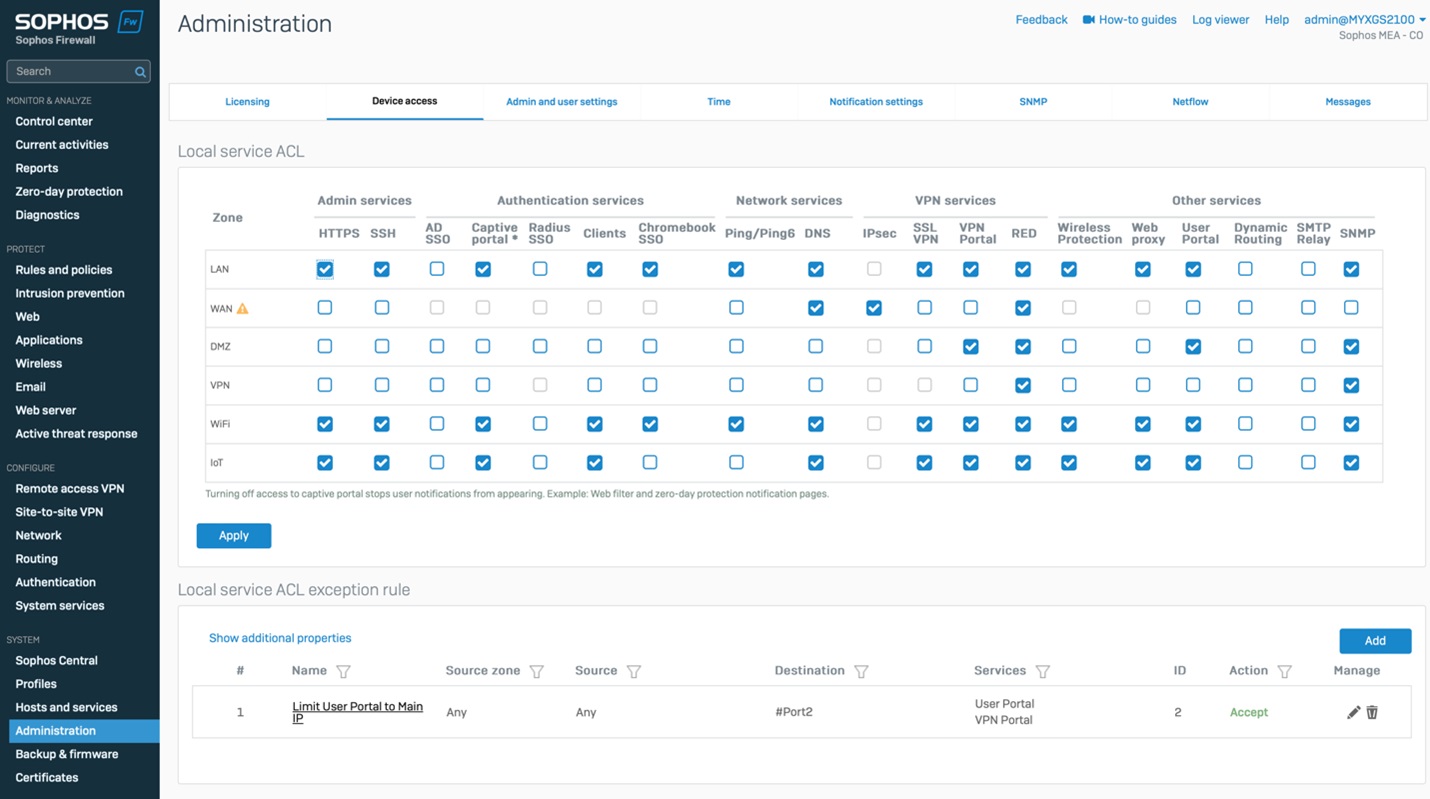
Hardened against attack
Taking measures to prevent attacks from targeting your firewall is critically important. Sophos Firewall has been designed from the start with security in mind and is continually being hardened against attacks with new technologies.
Sophos Central management offers the ultimate in secure remote management. Recent enhancements include improved multi-factor authentication, containerization for the VPN portal and other trust boundaries, strict default access controls, rapid hotfix support, and more, making Sophos Firewall a formidable opponent for attackers.
Automated hotfix response
Sometimes it’s important to patch urgent security issues quickly before the next regular firmware update. To that end, Sophos Firewall integrates an innovative hotfix capability that enables us to push urgent and important patches out to your firewall “over the air” to address any new zero-day vulnerabilities or other critical issues that arise between regular firmware updates.
While it’s still vitally important that you keep your firewall up to date with the latest firmware release (as every release includes important security fixes, as well as performance, stability, and feature enhancements), this enables a rapid fix to be applied without requiring any downtime normally associated with a firmware upgrade.
Proactive monitoring
You depend on Sophos to be proactive, transparent, and responsive. That’s why we continually monitor our global install base of customer firewalls and rapidly react to any incident.
This enables us to identify incidents before our customers thanks to telemetry collection and analysis. You can rest assured that if a single customer anywhere in the world has their firewall attacked, we’re working tirelessly to help shut the attack down and prevent it from happening elsewhere.
In addition, our mature vulnerability disclosure program ensures we’re transparent and communicative with every security vulnerability or incident, so you’re as well-equipped as possible to protect your network. We also offer the most active and well-funded bug bounty program in the industry to get ahead of any potential issues before they can become a problem.
Additional best practices
In addition to the best practices we build into your firewall, be sure to follow the Hardening Your Sophos Firewall Guide for additional best practices you should follow when setting up and administering your Sophos Firewall.
Download the Sophos Firewall Security Brief if you would like a PDF version covering these capabilities.
And if you’re new to Sophos Firewall, be sure to check out Sophos Firewall’s powerful protection features and take it for a test drive today.
Source: Sophos
600 IT/cybersecurity leaders share their ransomware experiences, revealing the realities facing education providers today.
Sophos’ latest annual study of the real-world ransomware experiences of educational organizations explores how ransomware’s impact has evolved in the last four years. It focuses on the full victim journey, from attack rate and root cause to operational impact and business outcomes.
This year’s report explores new areas of study for the sector, including an exploration of ransom demands vs. ransom payments and how often educational organizations receive support from law enforcement bodies to remediate the attack.
Download the report to get the full findings.
Attack rates have declined, but recovery costs have more than doubled
63% of lower education and 66% of higher education organizations were hit by ransomware in the last year, a considerable decrease from the 80% and 79% reported in 2023, respectively. However, the attack rates in education remain higher than the global cross-sector average of 59%.
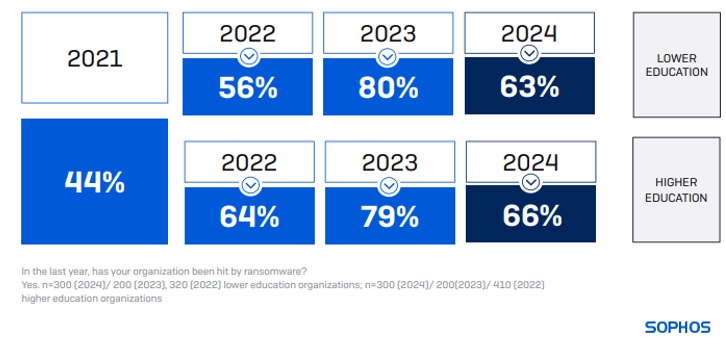
95% of educational organizations hit by ransomware in the past year said that the cybercriminals attempted to compromise their backups during the attack. Of them, 71% were successful, which is the second highest rate of successful backup compromise across all sectors after the energy, oil/gas and utilities sector.
85% of ransomware attacks on lower education and 77% on higher education organizations resulted in data encryption in the last year, slightly higher than 81% and 73%, respectively, reported in the previous year. For lower education, this is the second consecutive year of an increase in encryption rate, with only state/local government (98%) more likely to have data encrypted in an attack.
The mean cost in 2024 for lower education organizations to recover from a ransomware attack was $3.76M, more than double the $1.59M reported in 2023. Higher education organizations reported a mean cost of $4.02M, almost four times higher than the $1.06M reported in 2023.
Devices impacted in a ransomware attack
On average, 52% of computers in lower education and 50% in higher education are impacted by a ransomware attack, slightly above the cross-sector average of 49%. Having a full environment encrypted is extremely rare. Only 2% of lower education organizations and 1% of higher education organizations reported that 91% or more of their devices were impacted.

The propensity to pay the ransom has increased
62% in lower education paid the ransom to get encrypted data back, while 75% restored encrypted data using backups. At the same time, 67% of higher education organizations paid the ransom to restore data, whereas 78% used backups.
Higher education reported the second-highest propensity to use backups for data restoration along with state/local government organizations. It also ranks second highest in the propensity to pay the ransom to restore encrypted data, whereas lower education organizations rank third.
The three-year view of the education sector reveals an increase in backup use. In 2023, higher education was among the bottom three sectors globally for backup use, jumping to second place in 2024, alongside state/local government. Unfortunately, the propensity to pay the ransom has progressively increased for both lower and higher education organizations in the last three years.

A notable change over the last year is the increase in the propensity for victims to use multiple approaches to recover encrypted data (e.g., paying the ransom and using backups). This time, 65% of lower education and 69% of higher education organizations that had data encrypted reported using more than one method, almost three times the rates reported in 2023 (23% in lower education and 22% in higher education organizations.)
Victims rarely pay the initial ransom sum demanded
99 lower education and 92 higher education respondents whose organizations paid the ransom shared the actual sum paid, revealing that the average (median) payment in lower education was $6.6M last year. For higher education, the average (median) payment was $4.4M.
Only 13% of education victims said their payment matched the original request. 32% of lower education and 20% of higher education respondents paid less than the original demand, while 55% of lower education and 67% of higher education organizations paid more. Globally, higher education is the sector most likely to pay more than the original demand.
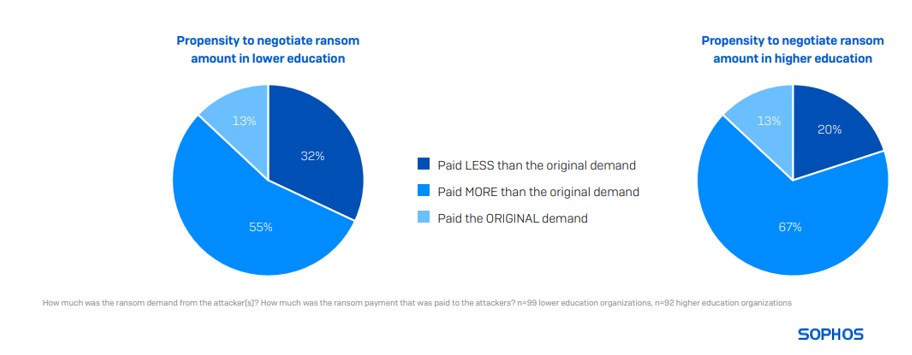
Download the full report for more insights into ransom payments and many other areas.
Source: Sophos
ustomers have spoken, recognizing Sophos as a Customers’ Choice vendor in the 2024 Gartner® Peer Insights™ Voice of the Customer Reports for Network Firewalls and Endpoint Protection Platforms.
These distinctions are based on a combination of customer review coverage and ratings and this is the third consecutive year when customers have recognized Sophos as a Customers’ Choice vendor in both markets.
In the 2024 Voice of the Customer Report for Network Firewalls Sophos scored a 4.8/5.0 rating based on 377 verified customer reviews as of 31st March 2024 – the highest number of reviews of any vendor. Sophos is also recognized with a Customers’ Choice distinction in five industry segments, and is the only vendor positioned in the Customers’ Choice Quadrant in the Services Industry segment.
In the 2024 Voice of the Customer Report for Endpoint Protection Platforms, Sophos also scored a 4.8/5.0 rating based on 682 reviews as of 30th April 2024 – once again, the highest number of reviews among all vendors in the report. Sophos was also named a Customers’ Choice vendor in all 11 industry segments mentioned in the report.
Customer testimonies
Here are some examples of what customers had to say about Sophos:
“Bravo Sophos for this outstanding firewall solution; you make our life easier!”
Technical Engineer in the Media industry, $50M-250M
Review link
“Sophos Firewall empowers secure network with robust protection and scalable solutions”
Senior Manager, IT in the Banking industry, $50M-250M
Review link
“Sophos Firewall is the best option out there to stay ahead of the threats!”
Associate Manager in the Manufacturing industry, $50M-250M
Review link
“Sophos Firewall is a marvellous solution that protects us against zero-day threats”
Security Engineer in the Media industry, $50M-250
Review link
“Sophos Endpoint provides the most robust anti-ransomware protection in the industry”
IT Manager in the Manufacturing industry, $50M-250M
Review link
“Sophos Endpoint protection combines multiple prevention techniques to reduce the attack”
IT Manager in the Education industry, Gov’t/PS/ED <5,000 employees
Review link
“Unmatched protection: Sophos Intercept X Endpoint delivers peace of mind”
Network Administrator in the Manufacturing industry, $30B+
Review link
“Sophos Intercept X [Endpoint] is one of the best products we have ever used”
IT Admin in the Transportation industry, $1B-3B
Review link
Explore Sophos solutions
Join the 600,000 organizations that trust Sophos to defend against ransomware and other advanced threats. Explore Sophos Intercept X Endpoint and Sophos Firewall today, and see why they are consistently a Gartner Peer Insights Customers’ Choice.
Source: Sophos
Active adversaries are highly skilled cybercriminals. They use hands-on-keyboard and AI-assisted methods to circumvent preventative security controls and execute advanced multi-stage attacks.
Organizations need adaptive security controls designed to detect, investigate, and respond to the approaches commonly used by these sophisticated threat actors. Effective response to advanced threats requires a toolset that enables security operators to make data-driven decisions faster and execute tasks with speed and efficiency.
Sophos continuously leverages the threat intelligence and cybersecurity expertise from our Sophos X-Ops unit, as well as telemetry from Sophos’ and third-party security solutions, to provide the strongest protection, detection, and response to the most advanced attacks. We are always innovating, and the latest enhancements to the Sophos Extended Detection and Response (XDR) platform provide even greater power to defend against active adversaries.
Enhanced Sophos XDR detections
Check out some of our latest enhancements in this quick demo video:
Configurable suppression rules
Security operators have greater control over the detections generated by the Sophos XDR platform using an intuitive suppression wizard, enabling analysts to focus on the most important detections and cases by suppressing confirmed-benign events. Granular rules can be created based on specific attributes including severity, detection type, MITRE ATT&CK details, and more.
Comprehensive detection summaries
Security operators need to make decisions and execute tasks at speed, so it’s crucial that threat alerts are immediately comprehensible to analysts of all skill levels. Sophos XDR detections now include “natural language” descriptions to help accelerate investigation and response.
Streamlined SophosLabs Intelix integration
Detections generated by Sophos Endpoint are now automatically sent to SophosLabs Intelix for threat classification and analysis. Detection details are now enriched with high-fidelity threat intelligence with no need to manually submit to SophosLabs.
Enhanced Microsoft 365 detections
Sophos XDR collects and analyzes comprehensive audit log data from Microsoft 365 and uses proprietary rules to identify more threats than Microsoft security tools can on their own. The latest Microsoft “platform detections” in Sophos XDR focus on identifying compromised accounts and Business Email Compromise.
The “Microsoft Office 365 Management Activity API” integration is included with Sophos XDR at no additional cost.
Sophos XDR Public APIs
Extending our open ecosystem approach, we’ve introduced two new APIs to enable organizations to integrate Sophos XDR data seamlessly into existing security operations tools and workflows.
Organizations with established security operations programs can use these new APIs to surface threat detections and case investigation details from the Sophos XDR platform in their security information and event management (SIEM), professional services automation (PSA), and IT service management (ITSM) tools, providing the flexibility to leverage these existing investments.
- Accelerate investigation and response – enable automated workflows that leverage Sophos XDR detections and case details
- Centralize analysis of security telemetry – correlate Sophos XDR detections with alerts and telemetry from other data sources
- Enrich with third-party threat intelligence – augment Sophos XDR detections with additional threat intelligence for added context
Learn more in our documentation: Detections API | Cases API
Increase multi-dimensional visibility with technology integrations
Active adversaries execute attacks that cross multiple domains across the victim’s environment – the full scope of which cannot be detected by a single point product. Telemetry from multiple sources is needed to provide a more complete view of an active adversary’s activity at each stage of an attack.
The Sophos XDR platform collects, correlates, and analyzes data from a wide range of event sources, while automated actions and optimized workflows allow analysts to detect, investigate, and respond to active adversaries at speed across all key attack surfaces.
We are constantly expanding our expansive partner ecosystem with additional turnkey integrations with endpoint, firewall, network, email, cloud, identity, productivity, and backup solutions.
New integrations available for Sophos XDR and Sophos MDR customers include the following:
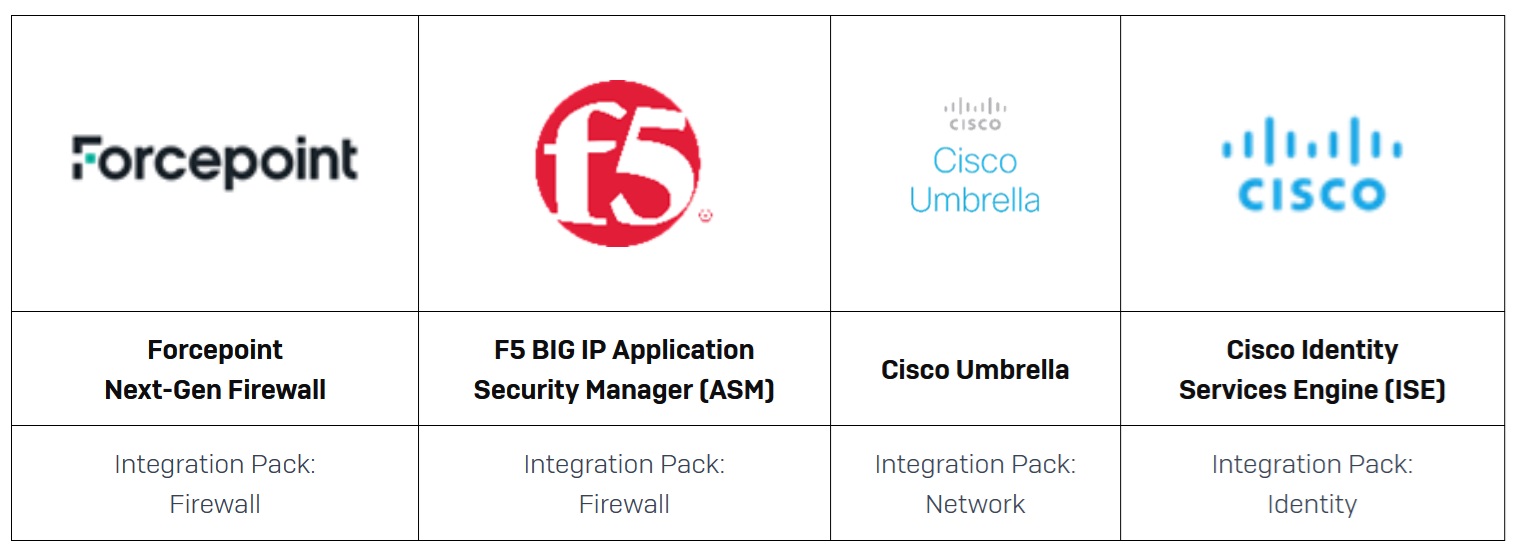
Microsoft Graph security integration (Version 2)
By ingesting, correlating, and analyzing telemetry via the Microsoft Graph security and Microsoft Office 365 Management Activity APIs, the Sophos platform uses advanced proprietary threat detection rules to identify threats that could otherwise be missed. These turnkey Microsoft integrations are included with Sophos XDR and Sophos MDR subscriptions at no additional cost, and over 20,000 customers are already using them to extend visibility and protection across their IT environments.
In July, we are releasing a new version of our Microsoft Graph security integration. The new version, called “Microsoft Graph security API (Alerts v2)”, provides additional information from a broad range of Microsoft security solutions that analysts can use to accelerate detection, investigation, and response. And yes, the new version will still be included in the standard price of Sophos XDR and Sophos MDR!
Quickly identify vulnerable endpoints and servers
Identifying devices that are potentially exposed to threats is critical for managing cybersecurity risk. We’ve recently introduced a new Device Exposure dashboard in the Sophos Central console that provides Sophos XDR and Sophos MDR with a clear overview of endpoint and server devices missing critical operating system updates. The visualization highlights the time elapsed since the last OS updates were applied, with one-click access to customizable queries for further details.
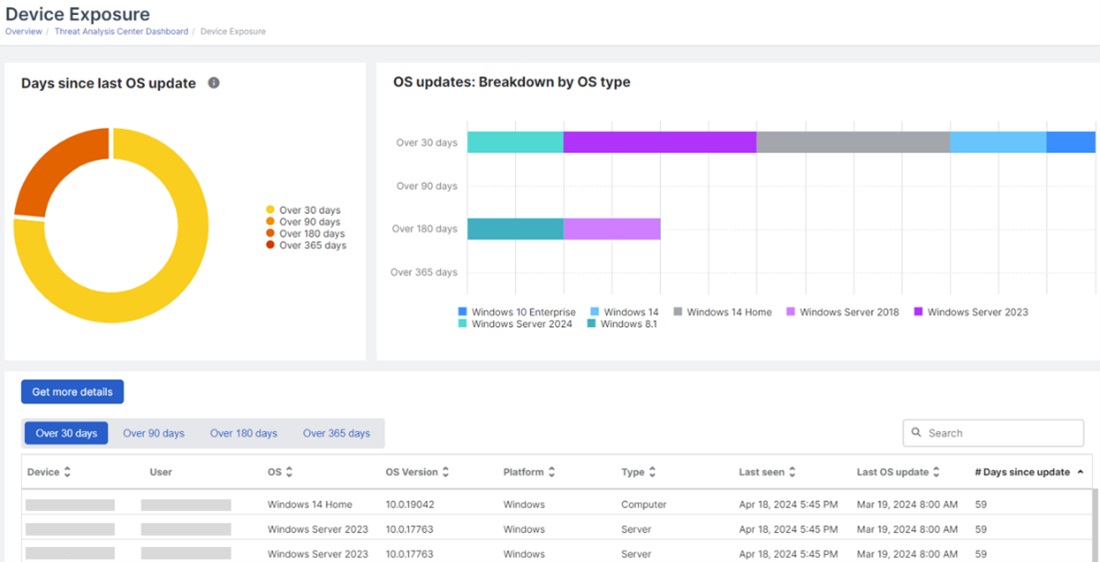
Learn more about the new Device Exposure dashboard
Vulnerability management delivered as a managed service
The modern attack surface continues to grow beyond the borders of traditional on-premises IT, and most organizations now have a significant number of internet-facing assets they don’t even realize they own, let alone understand whether they are vulnerable to attack. With our latest service offering – Sophos Managed Risk, powered by Tenable – our dedicated team of experts helps eliminate blind spots in your external attack surface and prioritizes remediation efforts based on the exposures that pose the highest risk to your organization.
Recognized by industry experts and customers
Sophos XDR and Sophos MDR continue to garner high praise from customers and industry experts for superior detection, investigation, and response capabilities.
Elevate your defenses against active adversaries
To learn more and explore how Sophos XDR can help your organization better defend against active adversaries, speak with a Sophos adviser or your Sophos partner today.
You can also take it for a test drive in your own environment with a no-obligation, 30-day free trial – available from our website or (for existing Sophos customers) directly within the Sophos Central console in just a couple of clicks.
Source: Sophos
592 IT/cybersecurity leaders share their ransomware experiences from the last year, revealing fresh new insights into the realities facing them today.
The latest annual Sophos study of the real-world ransomware experiences of financial services organizations explores the full victim journey, from attack rate and root cause to operational impact and business outcomes.
This year’s report sheds light on new areas of study for the sector, including an exploration of ransom demands vs. ransom payments and how often financial services organizations receive support from law enforcement bodies to remediate the attack.
Download the report to get the full findings.
Attack rates have remained steady, but recovery is more expensive
65% of financial services organizations were hit by ransomware in 2024, in line with the 64% rate reported in 2023 but above the rate reported in the previous two years.
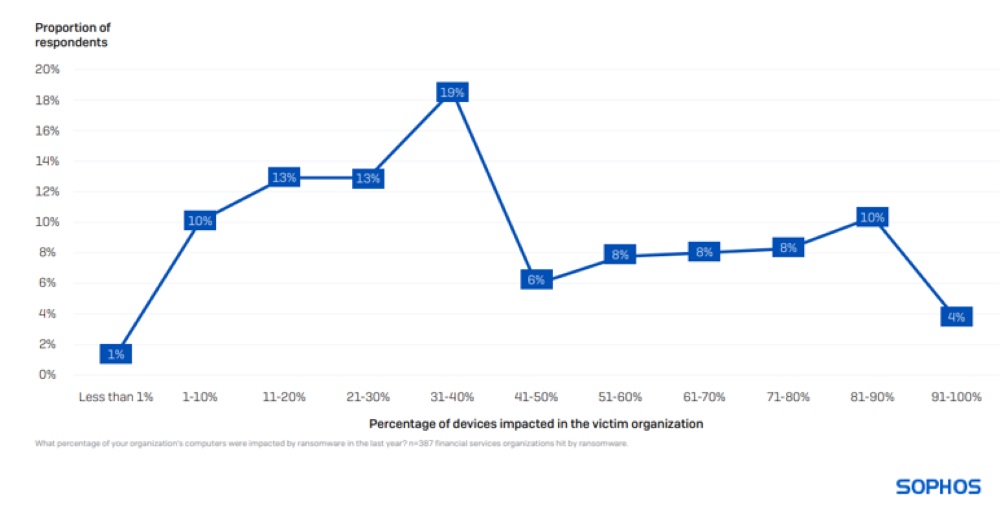
90% of financial services organizations hit by ransomware in the past year said that cybercriminals attempted to compromise their backups during the attack. Of the attempts, just under half (48%) were successful – one of the lowest rates of backup compromises across sectors.
49% of ransomware attacks on financial services organizations resulted in data encryption, a substantial drop from the 81% encryption rate reported in 2023. The sector reported the lowest data encryption rate across all sectors and the highest success rate in stopping attacks before data can be encrypted.
The mean cost in financial services organizations to recover from a ransomware attack was $2.58M in 2024, an increase from the $2.23M reported in 2023.
Devices impacted in a ransomware attack
On average, 43% of computers in financial services organizations are impacted by a ransomware attack, a little below the cross-sector average of 49%. Having your full environment encrypted is extremely rare, with only 4% of organizations reporting that 91% or more of their devices were impacted.

The propensity to pay the ransom has increased in financial services
62% of financial services organizations restored encrypted data using backups, and 51% paid the ransom to get data back. In comparison, globally, 68% used backups and 56% paid the ransom.
The three-year view of financial services organizations reveals that the gap between the use of backups and ransom payment has narrowed over the last 12 months. In 2023, 69% of financial services organizations used backups, and 43% paid the ransom to restore encrypted data after the attack.
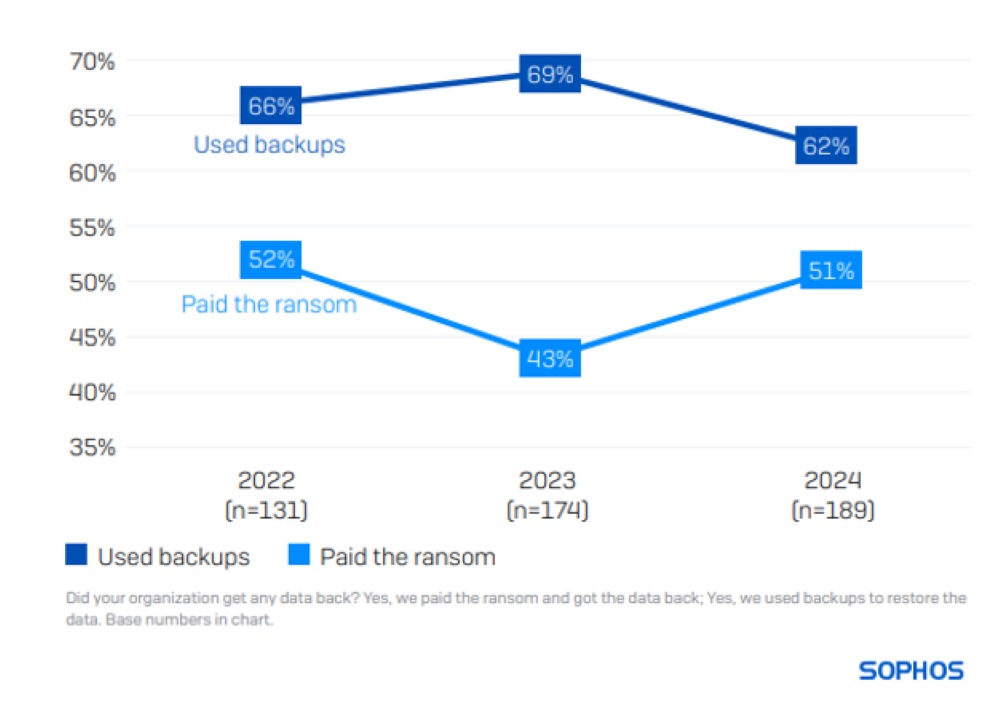
A notable change over the last year is the increase in the propensity for victims to use multiple approaches to recover encrypted data (e.g., paying the ransom and using backups). In this year’s study, 37% of financial services organizations that had data encrypted reported using more than one method, more than double the rate reported in 2023 (16%).
Financial services victims rarely pay the initial ransom sum demanded
90 financial services respondents whose organizations paid the ransom shared the actual sum paid, revealing that the average (median) payment was $2M in 2024.
Only 18% paid the initial ransom demand. 67% paid less than the original demand, while 15% paid more. On average, across all financial services respondents, organizations paid 75% of the initial ransom demanded by adversaries.
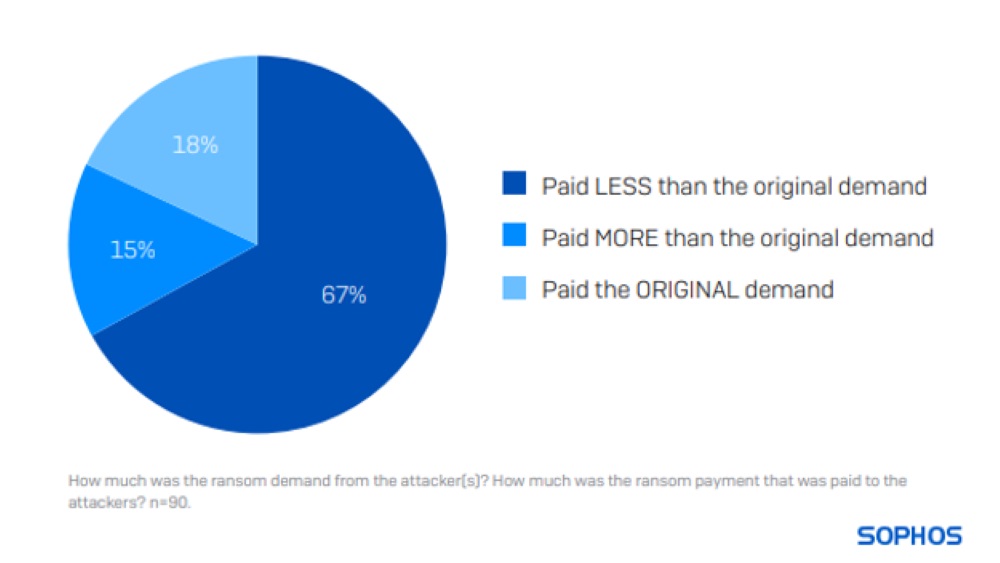
Download the full report for more insights into ransom payments and many other areas.
Source: Sophos
G2 just released their Summer 2024 Reports, and Sophos is the only cybersecurity provider named a Leader across the G2 Grid® Reports for Endpoint Protection Suites, Endpoint Detection and Response (EDR), Extended Detection and Response (XDR), Firewall Software and Managed Detection and Response (MDR). Once again, G2 users also rated Sophos as the #1 overall Firewall solution – the sixth G2 seasonal report in a row for this distinction. Mid-Market and Enterprise users also rated Sophos as the #1 solution.
Sophos MDR is also ranked highly in the Summer 2024 Reports, where users rated it as the #1 overall MDR solution among Mid-Market and Enterprise customers.

Independent Sophos Customer Validation
G2 distinctions and rankings are based on independent, verified customer reviews on G2.com, the world’s largest software marketplace and peer review platform. In G2’s Summer 2024 Reports, Sophos was named an Overall Leader in five categories, as well as a Leader in 18 individual market segment Grids:
- Endpoint Protection Suites: Overall, Enterprise, and Mid-Market Grids
- EDR: Overall, Enterprise, Mid-Market, and Small Business Grids
- XDR: Overall, Enterprise, Mid-Market, and Small Business Grids
- Firewall: Overall, Enterprise, Mid-Market, and Small Business Grids
- MDR: Overall, Enterprise, and Mid-Market Grids
What Sophos users are saying
“Sophos Firewall’s centralized management interface simplifies network security configuration and monitoring, providing a comprehensive, easy-to-understand view of security policies and events” said an IT Manager in the Enterprise segment.
“What stands out the most is how effortlessly Sophos Firewall streamlines security tasks, allowing users to focus on protecting their networks without getting bogged down in complex configurations” said a user in the Mid-Market segment.
“I don’t think I would personally sleep well at night if I didn’t know that Sophos MDR was monitoring our network 24/7/365” said an IT Manager in the Mid-Market segment.
“Sophos MDR has proven to be a fantastic cybersecurity solution for us. What really sets it apart is how quickly it can spot and deal with threats, keeping our systems secure with real-time monitoring and fast incident response” said a Systems Administrator in the Enterprise segment.
“Another thing that should be highlighted about Sophos MDR is the comfort and peace of mind of knowing that we will be notified by its team of professionals of any threat and of their work to resolve, stop and advise you to deal with that threat and thanks to its effectiveness it makes that for our part we have a low frequency of use” said a user in the Enterprise segment.
Elevate your cyber defenses with Sophos
As the G2 ratings illustrate, Sophos provides unparalleled breadth and depth of protection. Our world-leading endpoint, network, email, cloud, and security operations solutions defend over 550,000 organizations from advanced cyberthreats, including ransomware.
Whether you’re looking to upgrade your firewall, enhance your endpoint defenses, streamline and accelerate your threat investigations, or add 24/7 human-led threat detection and response, we can help.
Our solutions are tremendous on their own – and even better together. Customers running both Sophos Intercept X Endpoint and Sophos Firewall consistently report that they are able to double the efficiency of their IT/cybersecurity team and realize a reduction of up to 85% in the number of security incidents that require investigation. With Sophos you can build a long-term security strategy with confidence. Wherever you start, and whatever your goals, Sophos can help you enjoy superior cybersecurity outcomes.
For more information on our services and products, speak to your Sophos partner or representative and visit our website.
Source: Sophos
Security awareness training helps organizations worldwide reduce risks related
to cyber security, building vital threat resilience, and create a strong security-aware culture.
What is Security Awareness Training?
Security awareness training is the practice of educating employees, contractors, partners, and other stakeholders on how they can safeguard sensitive information from cyber threats. Additionally, this process also informs training participants on how they can keep various systems, networks, online accounts, and other digital assets safe from hackers.
Why is Security Awareness Training Important?
Security awareness training helps organizations reduce risk related to the human side of cyber security and build a strong security-aware culture across all business units. To achieve this, CISOs and other security leaders construct risk-based awareness training programs that targets unsafe behaviors like clicking on a phishing email link or downloading a malicious attachment.
![]() With a security awareness program in place, organizations strengthen information security and keep sensitive data like personally identifiable information (PII), intellectual property (IP), and accesses to confidential accounts, such as bank accounts. Awareness training can also ensure employees comply with industry or regional data privacy regulations, such as GDPR.
With a security awareness program in place, organizations strengthen information security and keep sensitive data like personally identifiable information (PII), intellectual property (IP), and accesses to confidential accounts, such as bank accounts. Awareness training can also ensure employees comply with industry or regional data privacy regulations, such as GDPR.
As organizations improve their security awareness maturity model, they often see a sharp decrease in cyber security-related costs, as well as a positive impact on their productivity, revenue generation, and brand reputation.
Does Security Awareness Training Work?
Because all cyber attacks are rooted in human behavior manipulation, security awareness training is the most effective tool to safeguard sensitive information from hackers. By giving employees the knowledge needed to detect and report common threats, organizations minimize the possibility of data breaches compromising their data.
That said, effective training is grounded in effective security awareness planning. An organization’s security awareness professionals must establish clear cyber security goals, the metrics they’ll use to measure performance, and actionable strategies to attain or exceed their aspirations. Boosting employees training participation and completion rates must also be considered.
According to the 2021 Gone Phishing Tournament results, one in every five end users click on suspicious phishing message links. Of those who clicked, three-quarters compromised their data. By implementing dynamic security awareness training options, organizations can avoid extended downtime, revenue loss, and other inevitable data breach consequences.
What Should a Security Awareness Program Include?
The best security awareness solutions combine a variety of different learning activities to deliver an engaging, informative, and fun (yes, work-based training can and should be fun!). Common training program components include (but are not limited to): online courses, quizzes, interactive modules like Serious Games, phishing simulations, and ongoing communication campaigns.
 Security awareness program topics will vary based on an organization’s goals and maturity level. However, it’s important to cover a solid spectrum of security awareness fundamentals, such as phishing, social engineering, ransomware, malware, email security, and password best practices. A solid knowledge foundation will improve knowledge retention and phishing simulation performance.
Security awareness program topics will vary based on an organization’s goals and maturity level. However, it’s important to cover a solid spectrum of security awareness fundamentals, such as phishing, social engineering, ransomware, malware, email security, and password best practices. A solid knowledge foundation will improve knowledge retention and phishing simulation performance.
How Do You Implement Security Awareness Training?
The goal of security awareness training is about more than meeting compliance standards or ticking corporate mandates off a checklist. Organizations must strive to build vital cyber threat resilience, based on real-world intel, and, using that momentum, foster an internal culture that prioritizes continuous security awareness education.
To get the most out of your training program, you must implement each element carefully and connect it to you an overarching information security vision. For most security awareness teams, a successful implementation will resemble the following process:
Baseline phishing test
To accurately gauge initial end user security awareness, perform an initial baseline phishing simulation test. The results of this exercise will infuse the result security awareness report with the intel needed to craft a focused, risk-based training strategy.
Expert planning and executive support
Before launching any awareness training initiatives, it’s vital to get executive support. This process can be made much easier by leveraging informed opinions based on your baseline security awareness report and industry expertise, such as in-house Terranova Security CISO resources.
Engaging, multilingual training content
To maximize your training program’s ROI, your security awareness content must be engaging, informative, and, above all else, provide a fun learning experience for all participants. Be sure to offer training content in various modules, formats, and languages, which will enable you to benefit from increased participation, reduced risk, and changed behaviors.
Phishing training modules
Every organization needs a safe way to train employees about real-world threats and put their cyber security knowledge into practice. Because of this, phishing simulations are a key ingredient for security awareness success. They can also allow your organization to assess training content effectiveness and ensure you’re always targeting the right behavior change.
Reinforcement tools
To support your awareness training initiatives with consistent, impactful messaging and learning opportunities, reinforcement and communication tools are essential. From newsletters and infographics to videos, web banners, and more, these assets help keep participation and engagement rates high while also emphasizing key cyber security topics.
Dynamic, real-time reporting
With the proper analytics and reporting infrastructure in place, making data-driven decisions via an in-depth security awareness report or dashboard is easy. By customizing a reporting experience to your organization’s unique needs and goals, you’ll be able to instantly see and synthesize course and simulation results, as well as optimize your program for the long term.
Source: Terranova Security
Sophos is a leader in next-generation endpoint and network security. As the pioneer of synchronized security Sophos develops its innovative portfolio of endpoint, network, encryption, web, email, and mobile security solutions to work better together.
All products that are deployed as part of the MSP Connect Flex program through Sophos Central will be included in the Datto Autotask PSA integration, including Intercept X, Disk Encryption, Endpoint, Mobile, Web, Email, Wireless, and Cloud Optix.
- Sophos Central will automatically create all products in Autotask PSA
- Sophos will automatically update the service contract nightly to provide up-to-date billing information on all Sophos products deployed across an MSP’s customer base
- The integration will provide ongoing, real-time data to Autotask PSA
- The integration additionally supports manual syncs to Autotask PSA
Available worldwide in English, German, French, Japanese, Italian, Trad. Chinese, Spanish, Portuguese, Korean.
About the Datto Autotask PSA integration
You can connect your Sophos Central Partner account to Autotask, which is a Professional Services Automation (PSA) tool, if the following conditions are met:
- You’re part of the Sophos Managed Service Provider (MSP) program.
- You use Sophos Central Partner.
- You use Autotask.
Sophos Central alerts can be synced into the PSA as tickets and can be acknowledged from both Sophos Central and the PSA system. Each PSA ticket includes a URL linking directly to the endpoint or server’s device details page, providing quick access to the Computer Summary or Server Summary pages. This eliminates the need to track email alerts, manually set PSA ticket attributes for PSA-ingested emails, acknowledge alerts separately in Sophos Central and Autotask, and manually search for customers and devices in Sophos Central.
You can synchronize your Sophos product usage data from your monthly customer accounts with Autotask. The ability to create Autotask services from Sophos, map those services to Sophos products, and set intervals for syncing license usage data into Autotask eliminates the need for manual updates in two places. This makes it easier to bill customers for the products they use.
MSPs can streamline alert management with enhanced PSA integrations
Sophos Managed Service Provider (MSP) partners benefit from lower overheads and increased operational efficiencies thanks to a unified Sophos Central security platform, security vendor consolidation, and integrations with popular MSP automation tools.
As part of the Sophos MSP Connect Flex program, our Datto Autotask and ConnectWise PSA integrations provide visibility of your customers’ usage for all products and services deployed through the Sophos Central platform, enabling you to easily bill for the solutions they use.
We are delighted to announce significant new enhancements to these PSA integrations to boost your team’s effectiveness and reduce the operational burden of alert management.
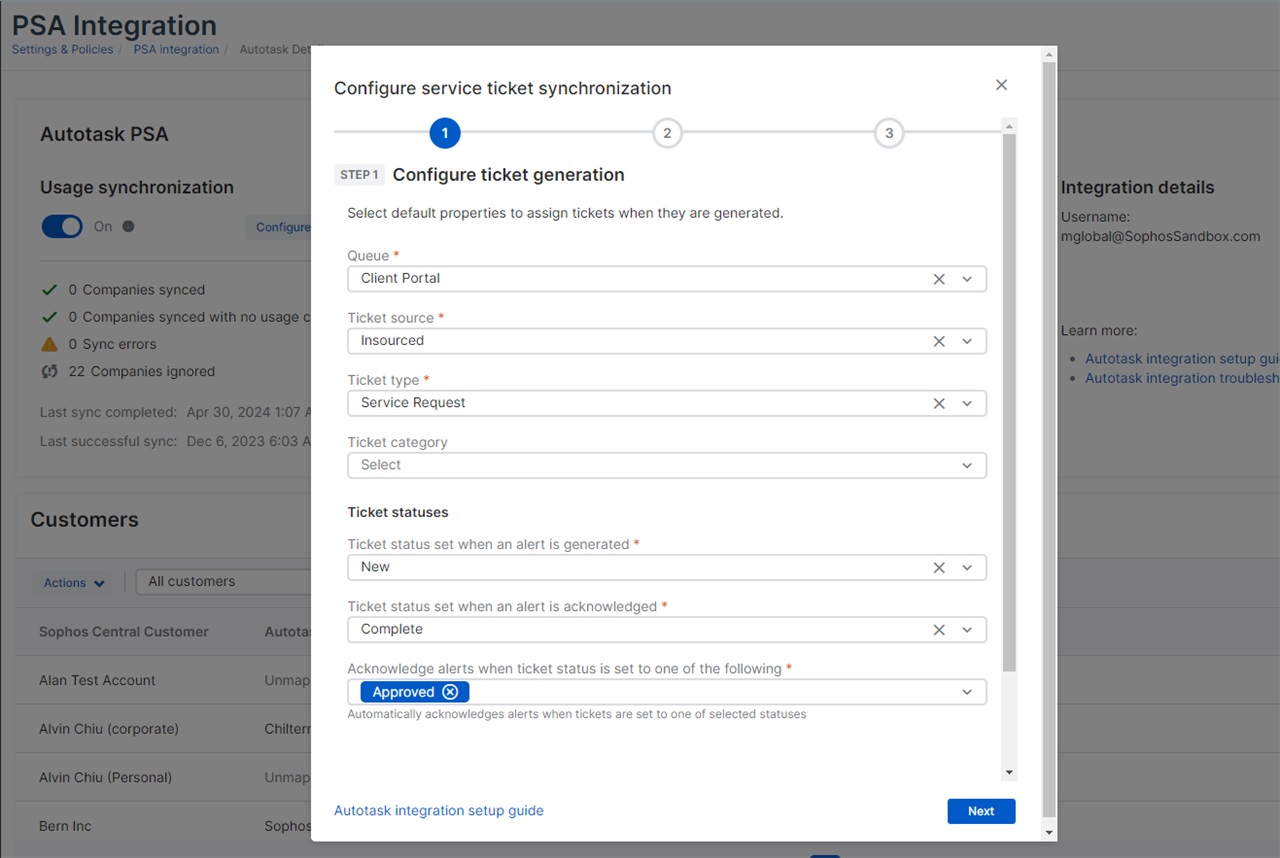
New Datto Autotask PSA ticketing integration
You can now automatically create Autotask PSA service tickets from Sophos Central alerts, saving your team significant time and effort.
- No need to track alert emails or log into Sophos Central to review and acknowledge alerts.
- The integration automatically assigns the severity, affected customer, and ticket category when creating Autotask PSA service tickets from Sophos Central alerts, removing this time-consuming manual task.
- Bi-directional synchronization means that closing a ticket in the Autotask PSA tool automatically closes the associated alert in Sophos Central – and vice versa.
- New deep links in Autotask service tickets provide direct access to ‘device details’ pages in Sophos Central. This enhancement removes the need to manually search for the customer and the device in the console – saving you an estimated 20 seconds for every alert, at a minimum.
Learn more here.
The Sophos Email and X-Ops teams are incredibly pleased to announce that Sophos Email has achieved top marks in VBSpam’s latest email comparative review for June 2024, earning it Virus Bulletin’s SPAM+ certification award.
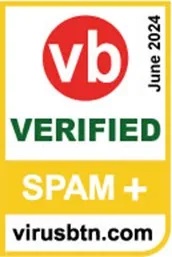 Sophos Email was the only solution to block all the malware and phishing samples in the test, while also classifying all ham and newsletter samples correctly with zero false positives.
Sophos Email was the only solution to block all the malware and phishing samples in the test, while also classifying all ham and newsletter samples correctly with zero false positives.
Over a 16-day period, this comprehensive evaluation bombarded our email security engine with over 140,000 malicious and spam-related emails, and our product correctly identified 100% of all the malware, phishing, and newsletter mail and 99.98% of other unwanted mail.
This test is a fantastic validation of all the investment and effort Sophos has made in ensuring customers get the best messaging protection for their organizations, keeping their inboxes clear of spam and security threats.
Learn more about Sophos Email.
Source: Sophos
MITRE ATT&CK® stands for MITRE Adversarial Tactics, Techniques, and Common Knowledge (ATT&CK). The MITRE ATT&CK framework is a curated knowledge base and model for cyber adversary behavior, reflecting the various phases of an adversary’s attack lifecycle and the platforms they are known to target.
MITRE Engenuity™ has released the results from the latest round of ATT&CK® Evaluations for Managed Services, assessing the abilities of 11 vendors to detect, analyze, and accurately describe real-world adversary behavior.
This was the second round of ATT&CK Evaluations for Managed Services, initially launched in 2022, to help organizations better understand how offerings like Sophos MDR can help protect them against sophisticated, multi-stage attacks.
Watch this short video for an overview of the evaluation:
What was the scope of the ATT&CK Evaluations?
MITRE Engenuity ATT&CK Evaluations are designed to simulate a representative example of how organizations should expect a managed service provider to engage with them during a sophisticated attack.
The MITRE Engenuity team emulates the behaviors of known threat actors during the evaluation. A ‘black box’ approach was used in this round, whereby MITRE did not disclose the simulated threat actor(s) or the technique scope until the assessment was complete.
This evaluation emulated tactics and techniques used by two known threat groups – menuPass and ALPHV/BlackCat – and assessed each vendor’s abilities to detect and report specific adversary activities.
In total, the evaluation comprised 172 adversary activities (sub-steps) across 15 overall steps. Note, however, that only 43 of the sub-steps – those that MITRE Engenuity considered critical for attack sequence success – were included in the results.
The evaluation focused entirely on detection and reporting. The ability to block, respond to, or remediate threats was not assessed. It’s essential, therefore, to keep in mind that adversary behaviors emulated in this evaluation may have been blocked by protection technologies (e.g., next-gen endpoint tools), which vendors needed to deactivate during the evaluation.
Evaluation participants
Eleven managed security service providers participated in this evaluation round:
| Bitdefender | BlackBerry | CrowdStrike | Field Effect |
| Microsoft | Palo Alto Networks | SecurityHQ | Secureworks |
| SentinelOne | Sophos | Trend Micro |
Sophos’ results
The results of MITRE ATT&CK Evaluations can be interpreted in multiple ways and MITRE Engenuity does not rank or declare any vendor a “winner” or a “leader”. Each vendor’s managed service reports information differently and each organization’s needs and preferences are just as important as the results themselves.
Sophos successfully “Reported” and accurately described 84% of the 43 adversary activities (sub-steps) selected by MITRE Engenuity – higher than the average among participating vendors. The majority (75%) of Sophos’ detections were also categorized as “Actionable”. “Reported” means the adversary activity was successfully identified, and sufficient context was provided. And, where the reported information also successfully addresses the “5 W’s” (Who, What, When, Where, and Why), the activity was further categorized as “Actionable”.

The results also include the number of alert emails sent by each vendor.
To ensure an effective, understandable, and actionable response, Sophos MDR focuses on providing high-value, human-written notifications containing the critical information and context that customers need to know.
During the 5-day MITRE ATT&CK Evaluation for Managed Services, Sophos MDR sent 24 emails. The average among other participants was over 120 emails, with some vendors sending more than 300 emails. Alert fatigue, caused by an overwhelming number of notifications from security solutions, is a major problem in cybersecurity. Sophos understands that your organization’s time is valuable, and when resources are limited, quality is typically better than quantity.
How to use results of MITRE Engenuity ATT&CK Evaluations
ATT&CK Evaluations are among the world’s most respected independent security tests, due in large part to the thoughtful construction and emulation of real-world attack scenarios, transparency of results, and richness of participant information.
When considering a Managed Detection and Response (MDR) service, be sure to review the results from MITRE Engenuity ATT&CK Evaluations alongside other reputable third-party proof points, including verified customer reviews, and analyst evaluations.
As you review the data available in MITRE Engenuity’s evaluation portal, look beyond the numbers and consider the following, keeping in mind that there are some questions about managed security services that the ATT&CK Evaluations cannot help you answer. For example:
- Does the service present information to you the way you want it, with high-value communications containing the critical information you need to know?
- Does the service assume you have an in-house security operations team, or can they provide a full ‘instant SOC’ with the ability to take action to eliminate threats on your behalf?
- Who will be engaging the managed service provider on a day-to-day basis? IT Administrators, experienced security analysts, or perhaps both?
- Can the service integrate with other technologies in your environment to detect and respond to multi-stage threats that extend beyond endpoints (e.g., firewall, email, cloud, identity, network, backup and recovery, etc.)?
- Does the service include full remote incident response, and are the included IR services limited to a fixed number of hours, or uncapped?
Why we participate
Sophos is committed to participating in MITRE Engenuity ATT&CK Evaluations alongside some of the best security vendors in the industry. As a community, we are united against a common enemy. These evaluations help make us better, individually and collectively, for the benefit of the organizations we defend.
Our participation in the latest evaluation further validates Sophos’ position as an industry-leading Managed Detection and Response (MDR) provider and trusted cybersecurity partner to over 22,000 customers.
To learn more about Sophos MDR and how it can support you, visit our website or speak with a security expert today.
Source: Sophos
Remote network monitoring allows IT to stay connected and monitor their organization’s network infrastructure from anywhere in the world. Remote network monitoring offers convenience and flexibility for network engineers managing off-site networks, IT consultants monitoring traffic for clients, managed service providers, or network administrators who simply couldn’t be on-prem on a given day.
By enabling IT to check the performance, security, and health of critical network devices at anytime and from anywhere, organizations can significantly minimize downtime. Instead of discovering issues upon returning to work, requiring the assistance of a local technician, or dispatching someone to the facilities, RMON allows IT to rapidly respond to network issues instantly from anywhere in the world.
What’s the Purpose of Remote Network Monitoring (RMON)?
Many modern organizations have network equipment located in multiple locations that they need to manage. Making sure routers, switches, servers, and other network equipment is up and running everywhere is critical to smooth business operations. But geographically-dispersed networks can make ensuring constant uptime a challenge for IT departments.
Also, in a mobile age, you and your staff are not always in a physical office. Sometimes you’re in the field. Sometimes you work from home. Maybe you have IT staff who work remotely and want remote network monitoring access. Can you give key IT personnel access to your network management tools from anywhere, without risking security breaches? Your organization needs the benefits of remote monitoring.
Remote network management allows IT to use tools to manage network performance no matter where your network devices (or you) are located. Think your company could benefit from remote network management and monitoring? Here are five ways remote access benefits you and your IT team.
Top 5 Benefits of Remote Network Monitoring
1. You can monitor remote offices wherever they’re located.
If your network spans multiple locations, a remote network monitoring software allows you to manage devices in every location. For instance, let’s say you manage the network for a school district with various campuses, or are monitoring local and regional branches of a financial institution. Remote monitoring tools give you visibility into how devices in your central location, as well as all the remote locations, are performing. You can also get alerts wherever and whenever performance falters. To easily distinguish office or branch locations, you can set up location-specific network maps tracking device statuses for that particular location.
Remote network management capabilities are especially helpful for companies who have a small team stationed in one spot but are responsible for managing the entire network. With remote network access, if a device goes down, you don’t have to travel to that location to troubleshoot. This saves IT administrators time, increases your productivity, and enables you to rest easy knowing the whole network is under your surveillance.
Consultants responsible for monitoring client networks and managed service providers (MSPs) also benefit from the ability to monitor a remote location without being on site.
2. IT staff in other offices can monitor the network in real time.
If you have IT team members spread out across locations who are responsible for monitoring network performance, remote access enables those IT staff in other offices, cities, branches, or even countries to view network performance in real-time—even if the software server is installed at headquarters.
This means if a device goes down at a remote location, a network guy located there can troubleshoot without necessarily getting you involved. He also doesn’t have to bother you to ask what you’re seeing on your end—he can see up-to-date network maps and metrics for himself.
3. You and your IT staff can be mobile without risking network neglect.
Having remote access to the network means your IT team doesn’t have to be on-site constantly. If you need to work from the coffee shop or at home, with remote access to the network you can still see the status of network devices on your laptop or mobile device. Mobile network monitoring keeps network data at your fingertips so you never risk outages from lack of access.
4. Access levels can be managed to ensure security.
Some network administrators may balk at the idea of remote access because of potential security threats to the network. One way to secure the network is to require encrypted authentication and make sure that every user has to log in the same way.
Another safeguard against security issues is the ability to customize user access. Most remote network monitoring tools allow you to give access at the admin or user level to certain maps or dashboards. Managing access for your users helps tremendously to keep the connection secure.
Also, find a tool that will update and provide patches whenever security holes surface. Although security threats are a fact of life, good tools will quickly notify users when a patch has been released so you can take advantage of increased security measures as soon as possible.
5. With proper connectivity, you’ll always have access.
To get remote access benefits, it simply requires… access. As long as you have direct access to the network via VPN connectivity or point to point, you’ll be able to manage and monitor all the critical devices within your network. Regardless of where you or they are located.
By allowing remote monitoring capabilities for you and your other IT network staff, you give yourself the kind of flexibility that the modern work world requires. You also gain peace of mind that no matter where you are, you can see the whole network at a glance, whether it spans a city, country, or the world.
What Does Remote Network Monitoring Software Help With?
If you’re managing the network across locations or on the go, it’s clear that remote monitoring is essential. Do you have the right tools? Remote network monitoring software can give you the visibility you need to monitor a widespread network.
Create a Dynamic Network Map
Remote network monitoring software like Intermapper allows you to create a dynamic network map, offering a real-time view of your network’s status. With color-coded indicators, you can easily see which devices are functioning and which are experiencing issues. Various map layouts and icon options let you customize the view to reflect your unique IT environment.
Minimize Impact on Users
Remote network monitoring software keeps you informed by sending real-time alerts via text, email, sound, and more whenever there’s a problem. This enables you to address and resolve technology issues swiftly, minimizing impact on users or customers.
Troubleshoot Problems Quicker
Quickly identify and resolve problems across your distributed network in seconds rather than hours. This efficiency saves you and your IT team time, reduces frustration, and ensures customer and user satisfaction.
Source: Fortra





